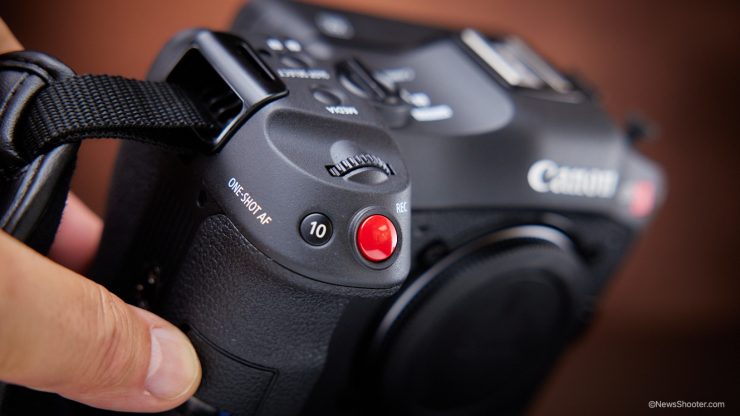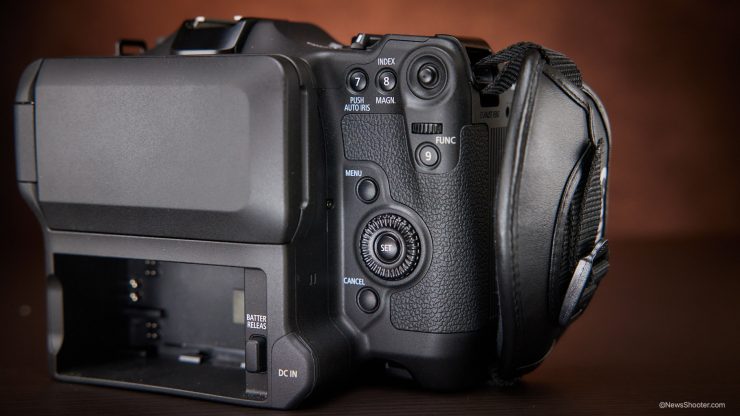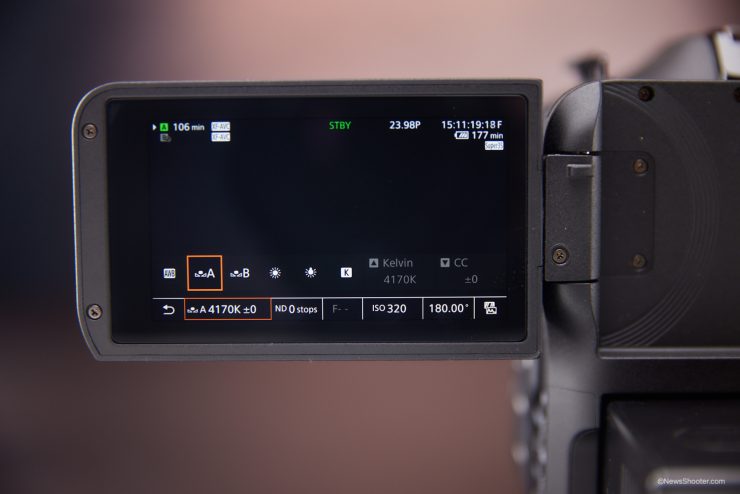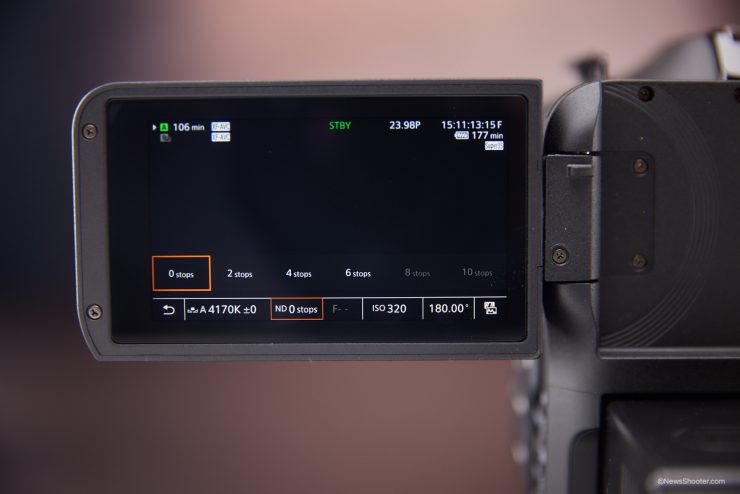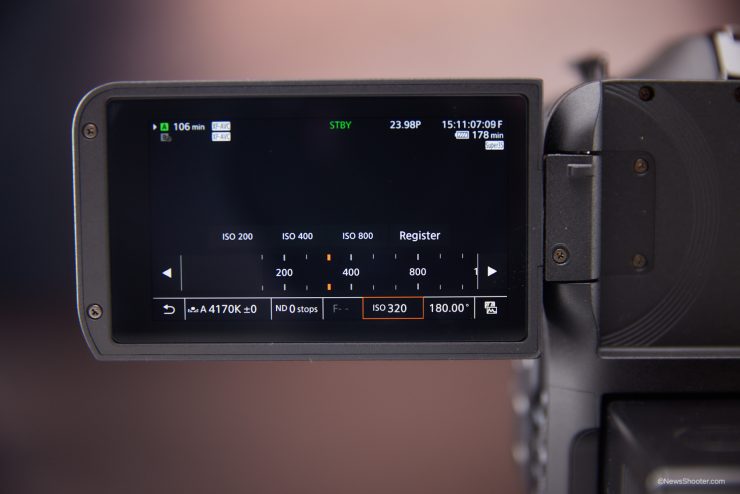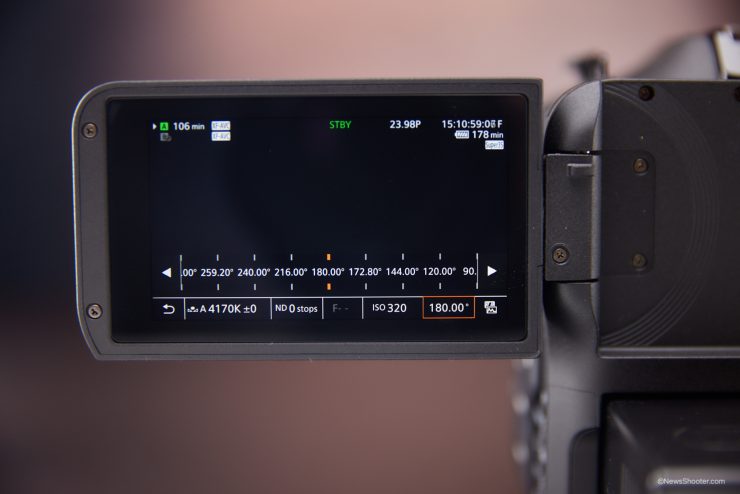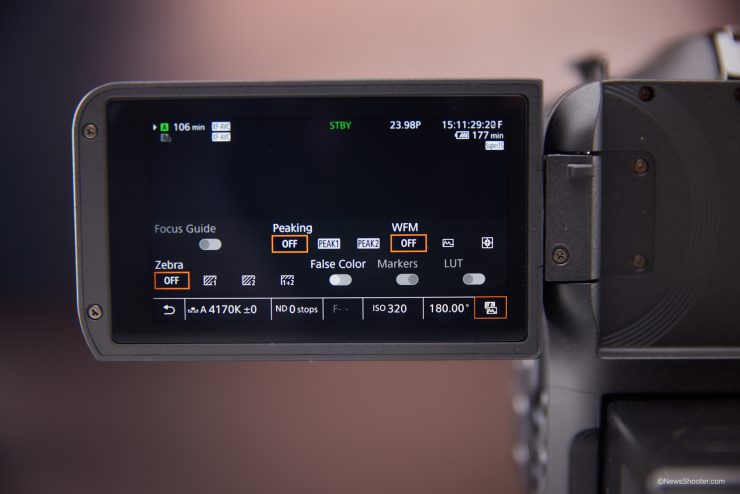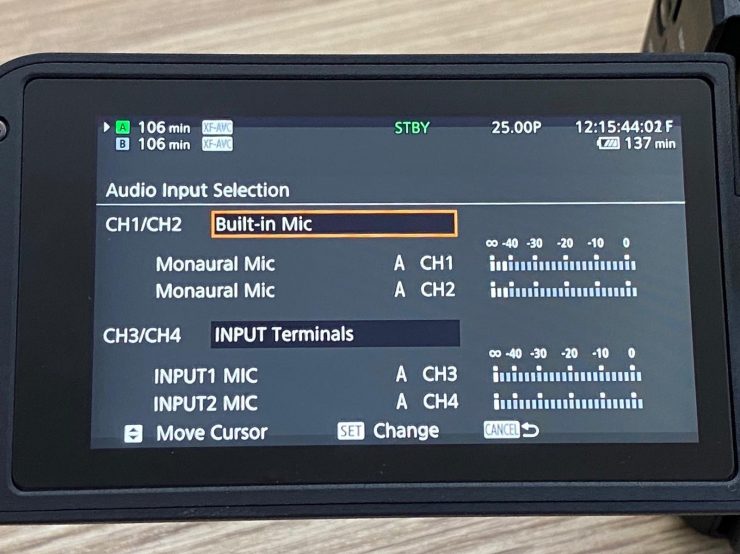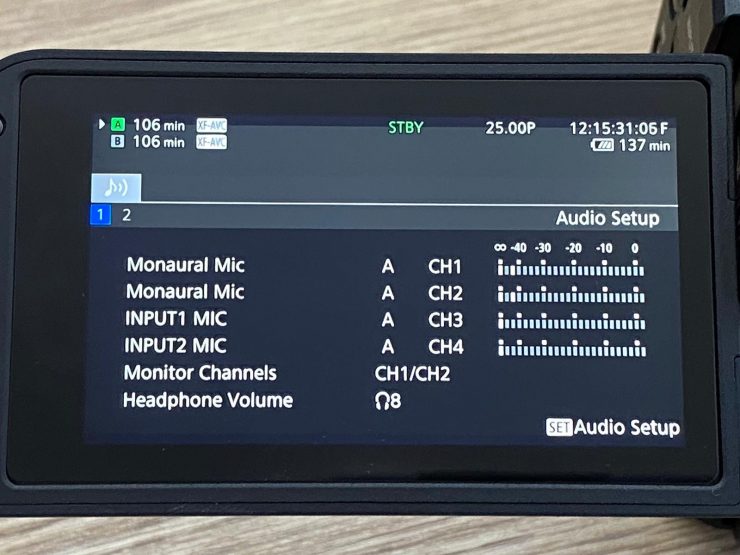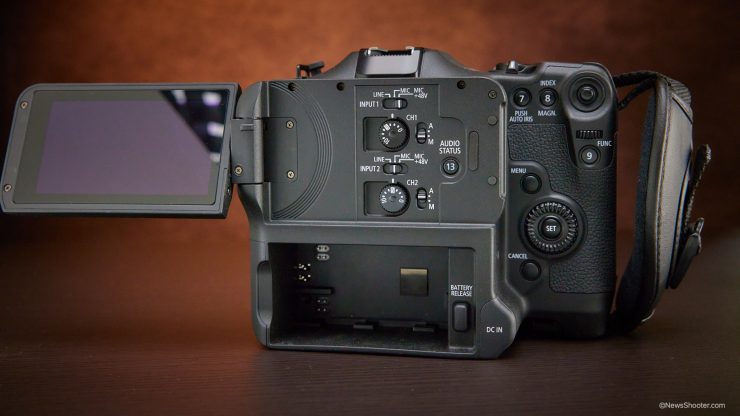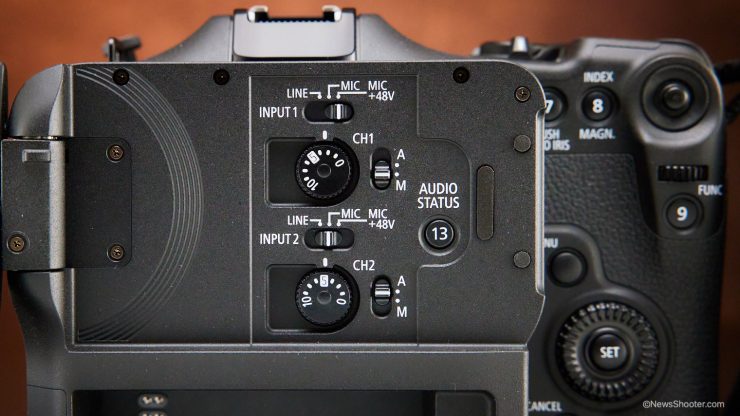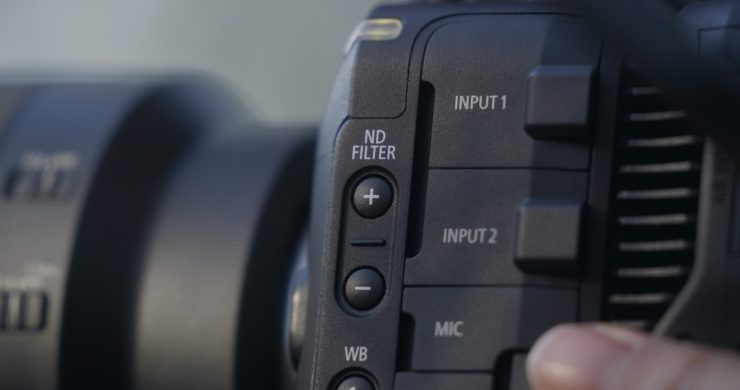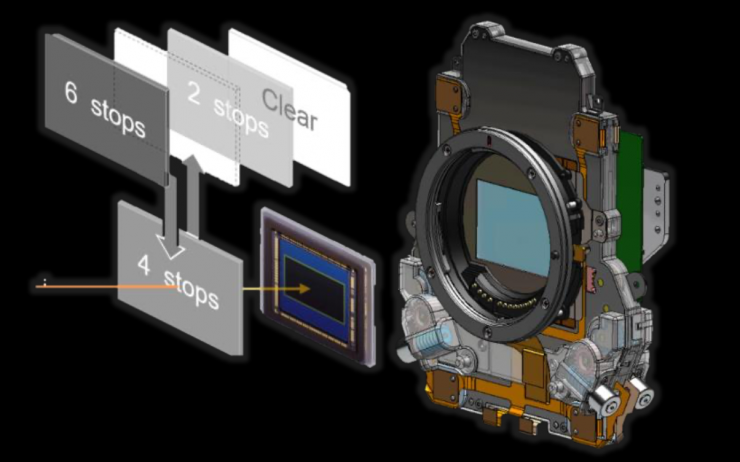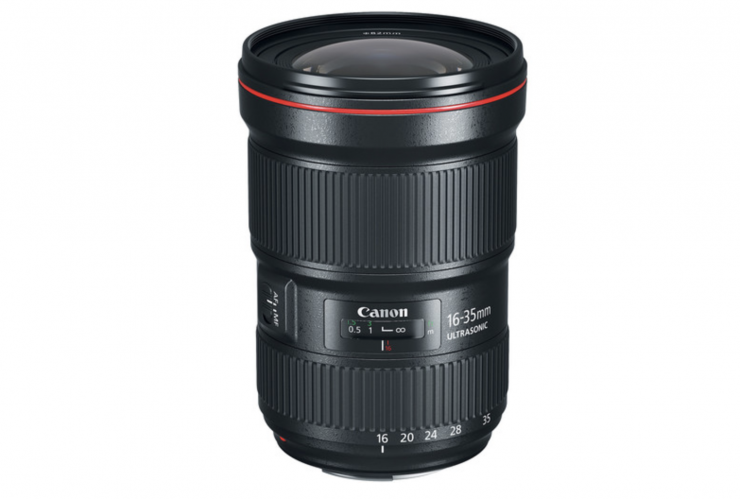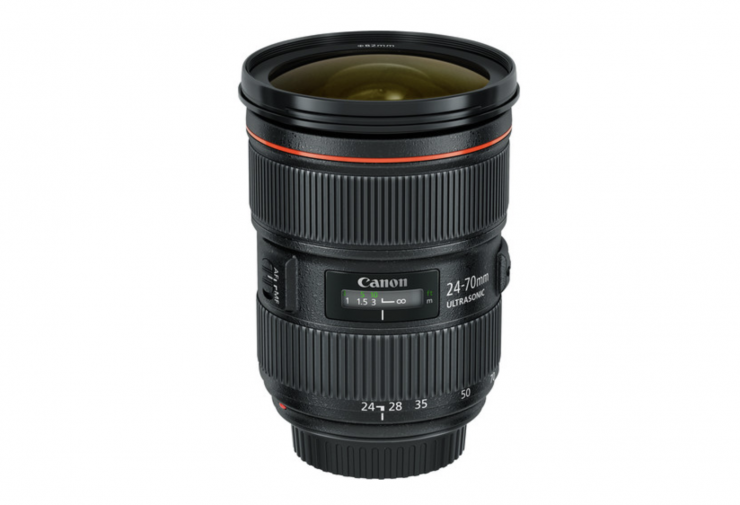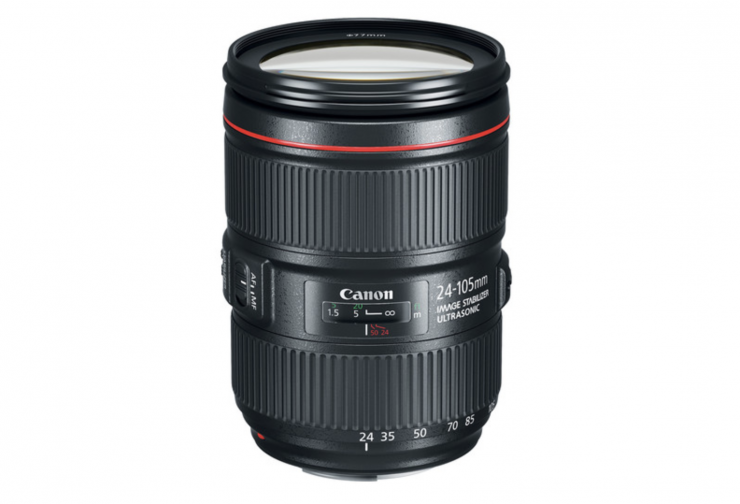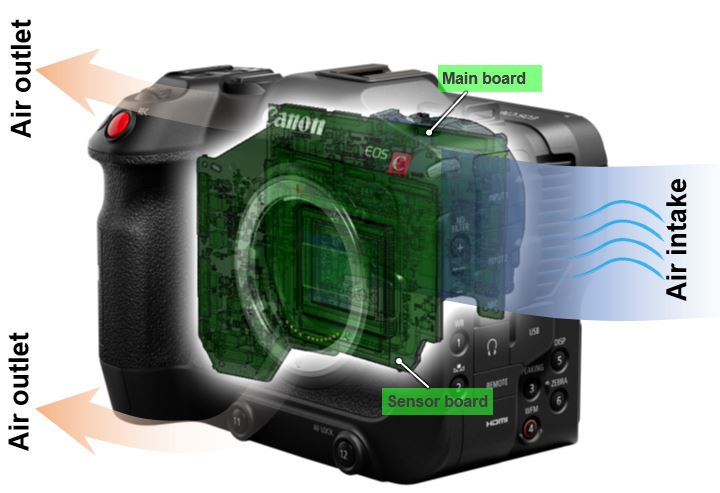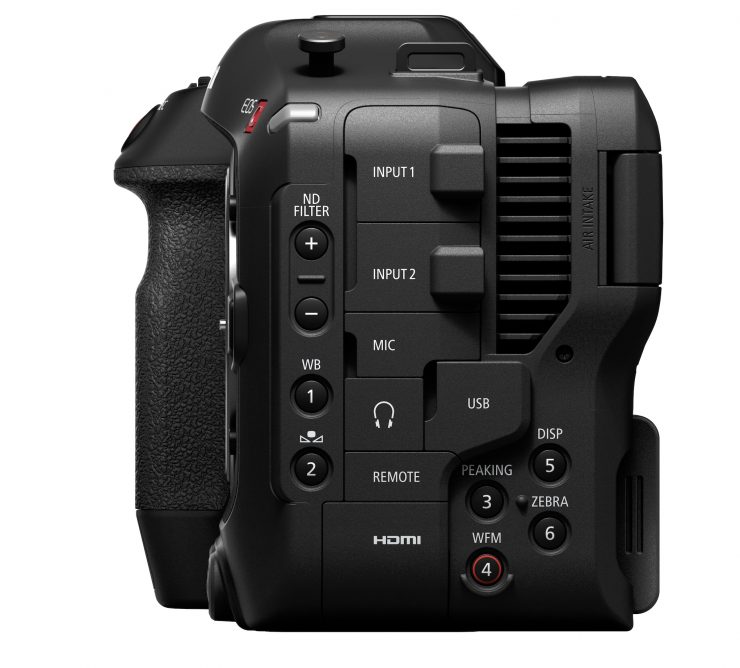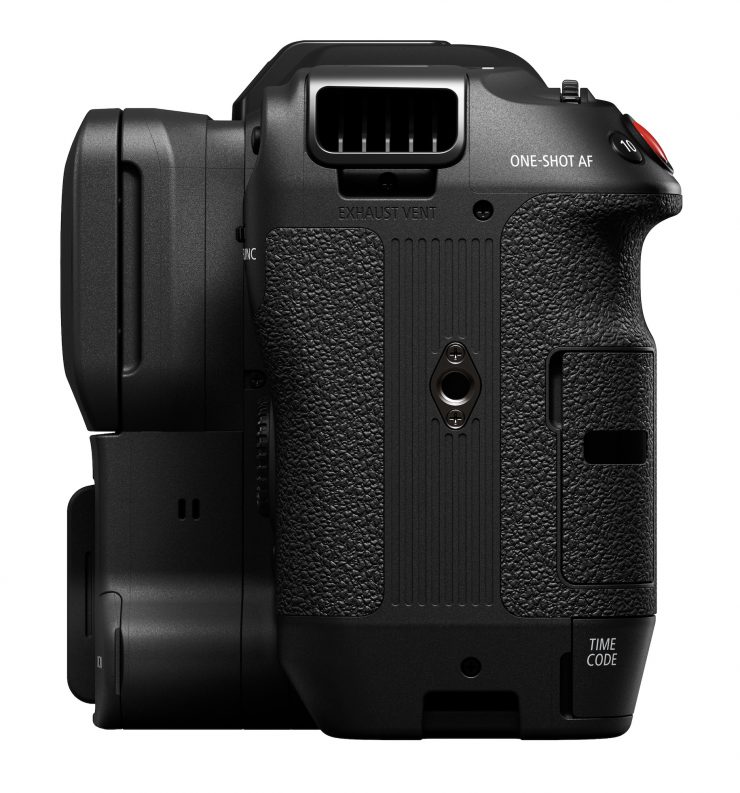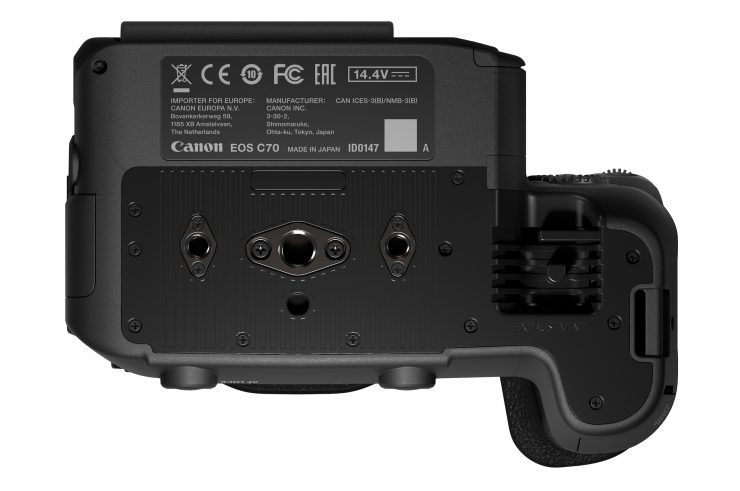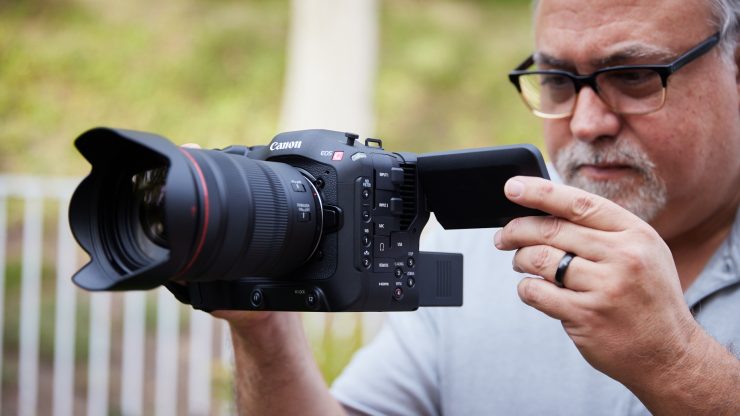
The Canon C70 was announced on September 24, 2020, and started shipping by the end of 2020. Availability was very low, and backorders were being filled at a snail’s pace. It’s now March 2021, and the EOS C70 is finally available at B&H and many other retail outlets. I’m bringing this up because we here at Newsshooter.com have been waiting to get our hands on one for months. we even signed an NDA and knew it was coming. Canon USA was not very helpful either in getting a preproduction or a sample version, so I would like to say THANK YOU! B&H for sending us a loaner for this better late than never review.
Hybrid or Video Camera?
The EOS C70 is a cross between a mirrorless style camera and a cinema camera. This design is something many people wanted, well people actually wanted a hybrid with all the features of a cinema camera, but Canon refused to make that one, yes the new EOS RF mount cameras have much-improved video specifications than the DSLR models in the past, but I/O has always been lacking for video as well as specs. Remember when a simple headphone jack was omitted from cameras?
The Panasonic GH line sort of became the standard for the true hybrid with many video features found in a cinema camera.
I’m not a huge fan of shooting video-solely with a mirrorless camera because they need some workarounds since they’re primarily designed for stills. I subscribe to the idea of the right tool for the job. Before you send me hate mail, I understand the need for small higher quality cameras for gimbals, drones, and tight locations. However, making one your primary video camera is just not my cup of tea. I’m actually a coffee drinker.
the C70 doesn’t shoot stills or have any frame capture options.
What’s Included?
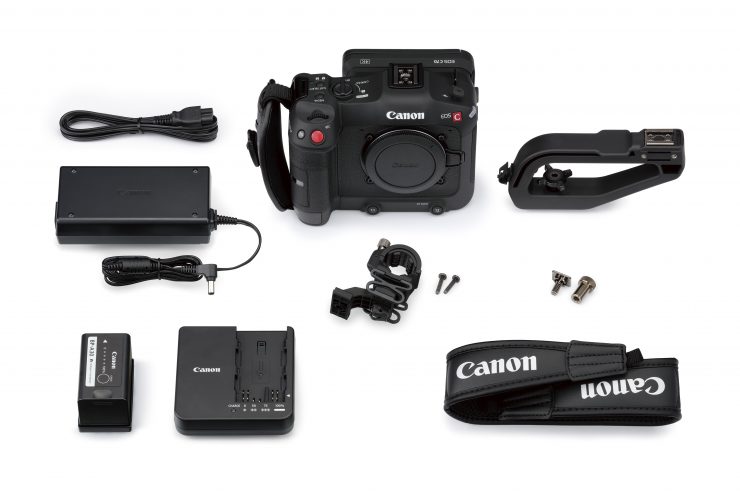
- C70 camera body
- Mic Holder
- Mic holder adapter
- Handle
- Tape measure hook
- Grip belt
- Shoulder strap
- One BP-A30 battery
- Body cap
- Battery charger CG-A20
- AC adapter CA-CP200 L
C70 Key features
- RF mount
- Super 35 sensor with DGO (same sensor as C300 III)
- 4K 120p no crop 4:2:2 10-bit recording
- 2K 180p crop
- Built-In ND filters
- HDMI output up to 4K DCI 4:2:2 10-bit
- Dual mini-XLR
- Timecode IO
- Full-sized HDMI
- Dual SD card slots
- Extended Auto Focus (Dual Pixel CMOS AF + EOS iTR AF X )
- Articulating touch screen
- No recording time limits
- Compact size
Form Factor & Controls
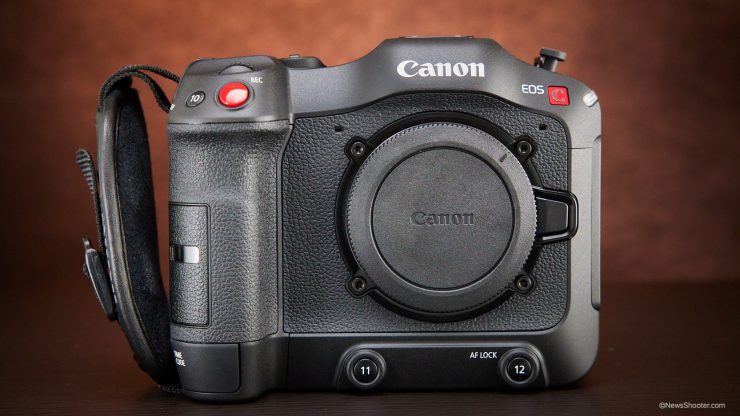
The C70 comes in at 2.58 lb (1.17 kg). It has physical dimensions of (H) 130.2 mm / 5.1″ x (W) 160 mm / 6.3″ x (D) 115.9mm / 4.6″.
From the front, it looks like an EOS 1DX without an EVF. The compact size of the C70 makes it a good contender for gimbal setups and quick handheld shooting.
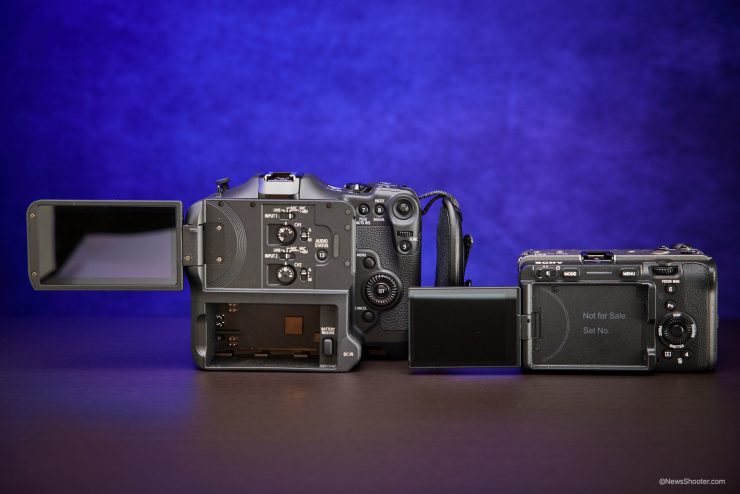
It’s not a small camera especially if you compare it to the Sony FX3.
Holding the C70 with a Canon RF 24-70 F2.8 attached, it has some heft. Not having an EVF also means you will be holding the C70 either mid-chest or close to eye level. This isn’t very easy to do for very long, and you lose the third point of contact for stability. A lens with image stabilization will be needed for handheld shooting to keep the jitter at a minimum.
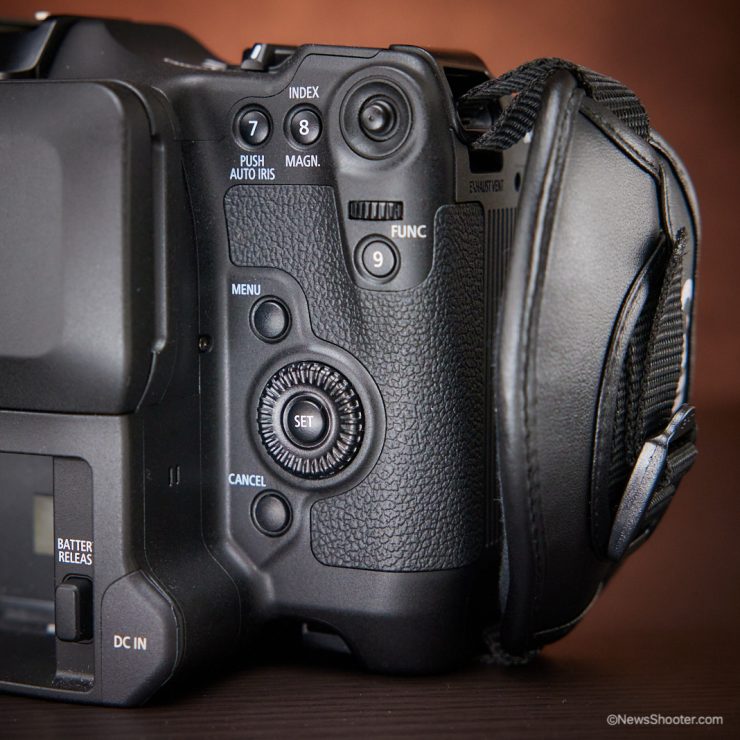
The included wrist strap is nice and necessary as it helps you hold the camera-less firmly when you want to use the buttons that are close to your fingers, and there are several. Canon did a nice job adding a lot of function buttons all over the C70 body.
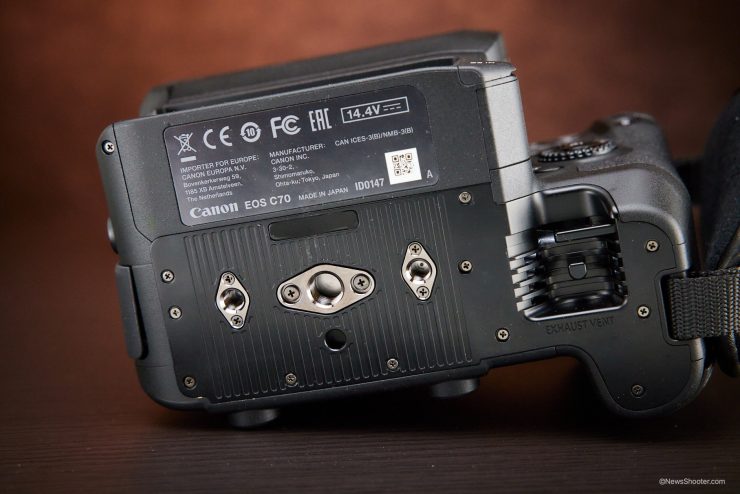
One issue for me is the tripod mounting position on the bottom of the camera. It’s going in the wrong direction for video QR plates. This is clearly a miss communication with video and stills design. To avoid the QR plate from twisting and loosening, the plate needs two screws. The C70 has three mounting points but in the wrong direction. Yes, it does have a hole for a Manfrotto type plate with the front peg to assist with anti-twist; However, that doesn’t help me as I use Arca/Swiss type plates and clamps on all my cameras.
Weight
Below is a list of several Canon cameras to better understand the weight and how it compares to other Canon cameras.
| CAMERA | WEIGHT |
| CANON C70 | 1.17 kg (2.58 lb) |
| CANON R5 | 738 g (1.62 lb) (Body with Battery and Memory) |
| CANON C200 | 1.5 kg (3.2 lb) |
| CANON C100 Mark II | 1.5 kg (3.2 lb) |
| CANON C300 Mark III | 1.77 kg (3.9 lb) |
| Canon XC15 | 910 g (2 lb) |
| CANON 1D C | 1.5 kg (3.5 lb) |
| CANON 1D X Mark III | 1.25 kg (2.75 lb) (Body Only) |
Does the C70 Need a Cage?
I seem to always put a cage on a video camera since I tend to want more gear on a camera than one cold shoe can handle. The first thing to look for is to make sure none of the valuable buttons and inputs are blocked. This requirement is harder with a camera that is covered in buttons and functions.
I would like to attach an EVF on the left side for certain situations when a viewfinder on top is too tall; however, that makes it a little tight to get access to the buttons and using the flip-out touch screen. With a smaller body, you have to make creative decisions on how you use external devices.
Multi-functional Grip
The C70 grip is a cross between a Cinema EOS and EOS RF camera. It’s packed for your right-hand assignments. Three custom dials and a joystick are placed on the grip. On top, you have the main power switch. The C70 powers up very fast at around 3-seconds.
Missed Opportunity with the Cold Shoe
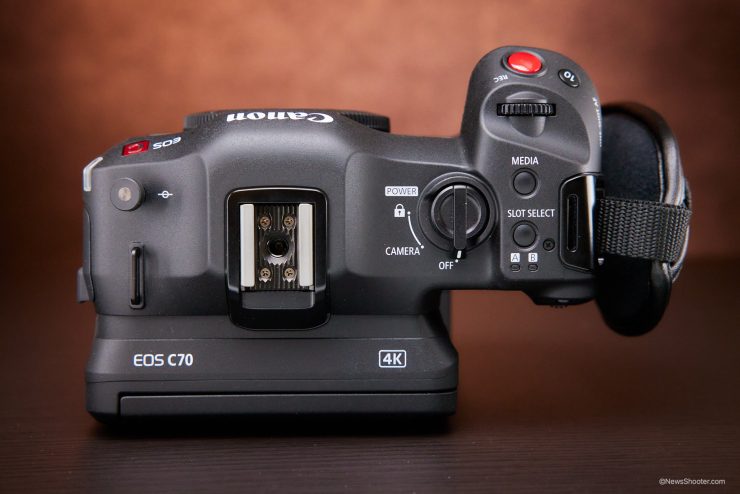
Here is where Canon had a chance to do something special with the coolest add-on, but it didn’t happen.
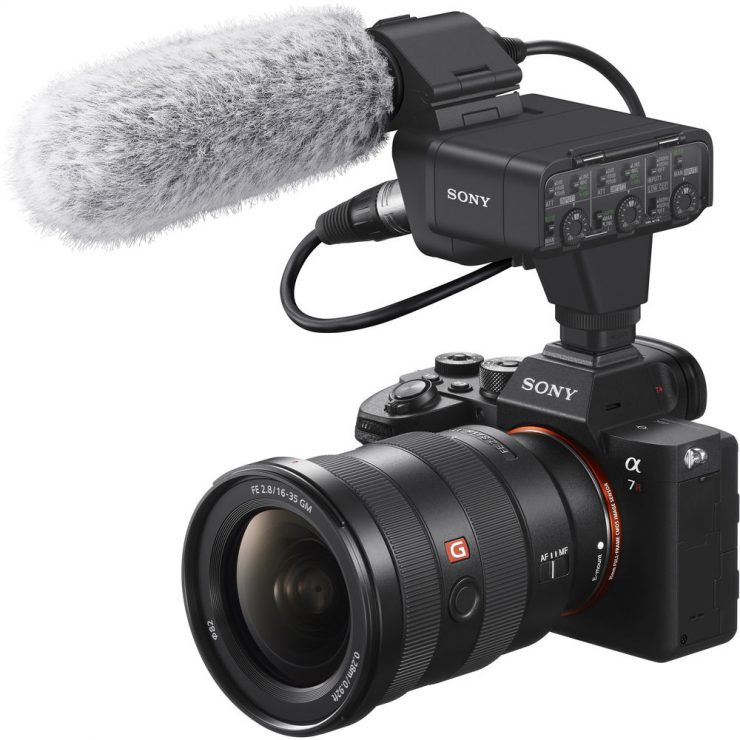
The cold shoe is only for mounting an accessory like the included handle, but if it was a hot shoe with contacts, the C70 would be able to have add-ons such as the Sony XLR-K3M Dual-Channel Digital XLR Audio Adapter that gives you 2-XLR inputs.
Sony has had this set up for some time now and is included in all the mirrorless cameras, including the a6000 line. It’s not perfect, but it sure is handy. Canon could have taken this idea to the next level. Since the C70 has no EVF, Canon could have made one that slides in, connects, and powers directly from the camera. Think of it as the same one in the EOS R5, only in a little box. That would have solved a big issue with the camera for me.
The custom dials can be set to perform various functions. Along with iris and ISO/gain, WB selection and color temperature have now been added. This is useful in a lot of shooting scenarios.
Fixing the Lack of an EVF
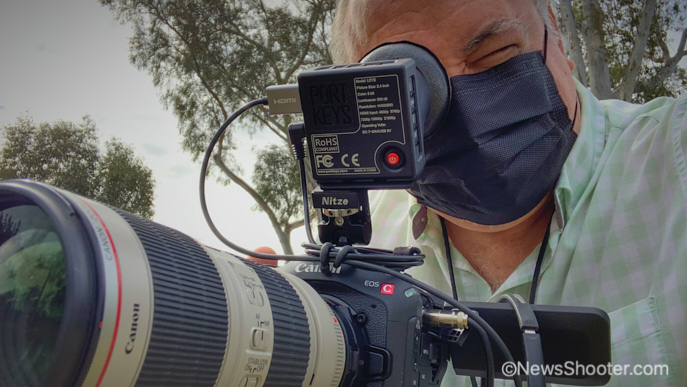
I recently reviewed the PortKeys LEYE EVF and found it a very good option in the $399 price range. To date, I don’t think you can get a better viewfinder for less or equal price. The C70, like the Z Cam or other box cameras, needs monitoring. The touchscreen LCD is great as it adds a few features I like to use, and covering it with a loupe might not be the way to go. With a few bits, I got the LEYE mounted on the C70, and it works very well.
Bits and Pieces Needed
To get the PortKeys LEYE to play well with the C70, I had a few hurdles to deal with. Mainly powering it. The LEYE doesn’t have an on-board power option, so you have to power it externally. In my review, I mentioned it was a miss not to add an LP-E6 type battery on the back. Maybe V2?
To power the LEYE, you could add a 5V portable battery to the back with some Velcro and use either the USB or the 5.5 x 2.5mm DC input. The barrel connector is a better option. When using the USB input, the power switch doesn’t work, and the LEYE stays powered up. You have to unplug it, or you will drain the battery.
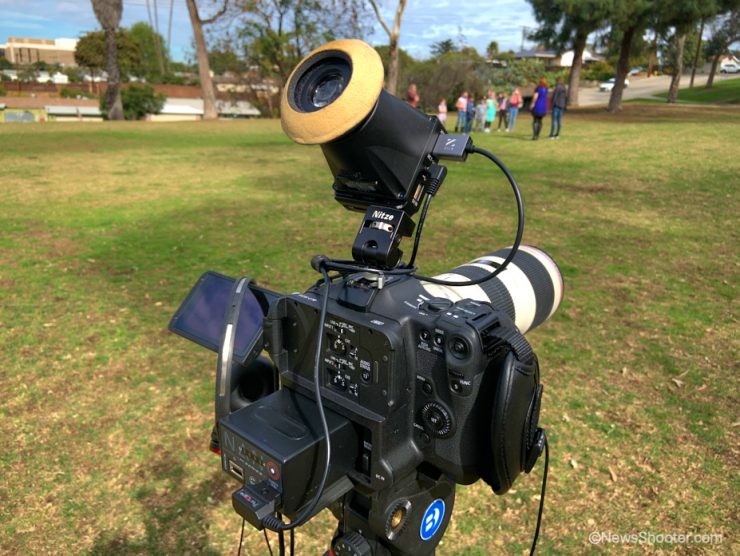
Speaking of batteries, the best option is the Core SWX Nano-C98. It has both USB and D-Tap power taps that work perfectly with the LEYE. Now I have one powering solution for both C70 and EVF.
With powering the LEYE solved, I needed an easy way to mount the EVF. Without a cage, my only option is to use the cold shoe. The C70 has a very solid cold shoe. It needs to be as it’s designed for the handle.
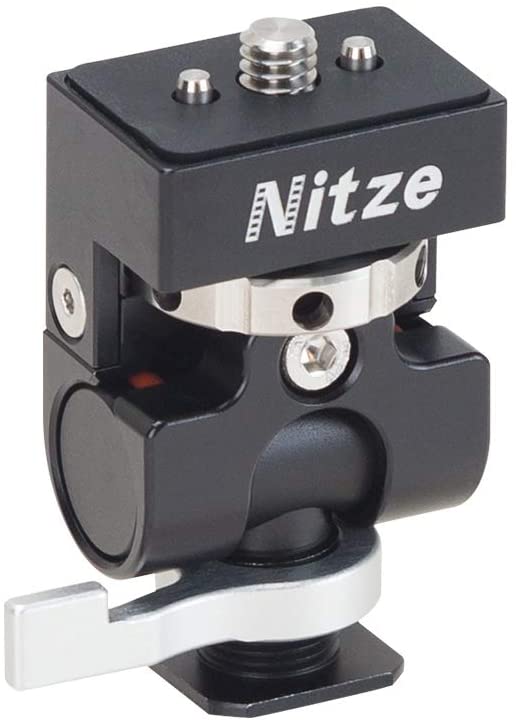
I picked up a Nitze Monitor Holder Mount that is fairly low profile. The big plus is it pans and tilts and holds in place. The tension is adjustable with a simple screw. Over time these can get loose, so keeping a hex wrench in the bag is a must.
I like the way it locks down with the lever. This makes it easy to get the mount nice and tight on the cold shoe. Another big plus is the Nitze has a 1/4”-20 screw with locating pins similar to the Arri accessory mount. The LEYE’s mount has a slot along the NATO rail where the two pins fit in. This is great as the EVF won’t twist and is rock solid.
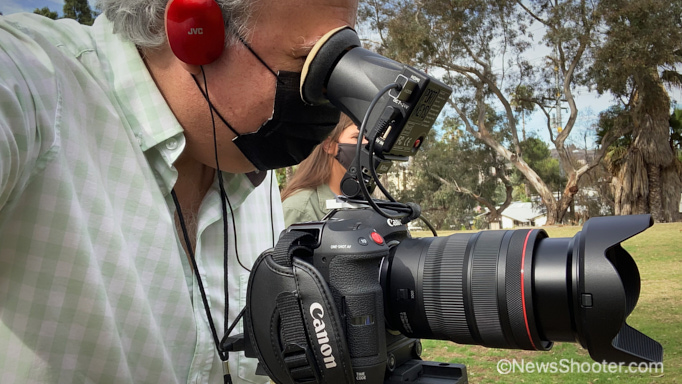
Yes, it is a little bulkier, but it will be a lifesaver if you are shooting outside in the sun.
Shortcut & Feature Buttons
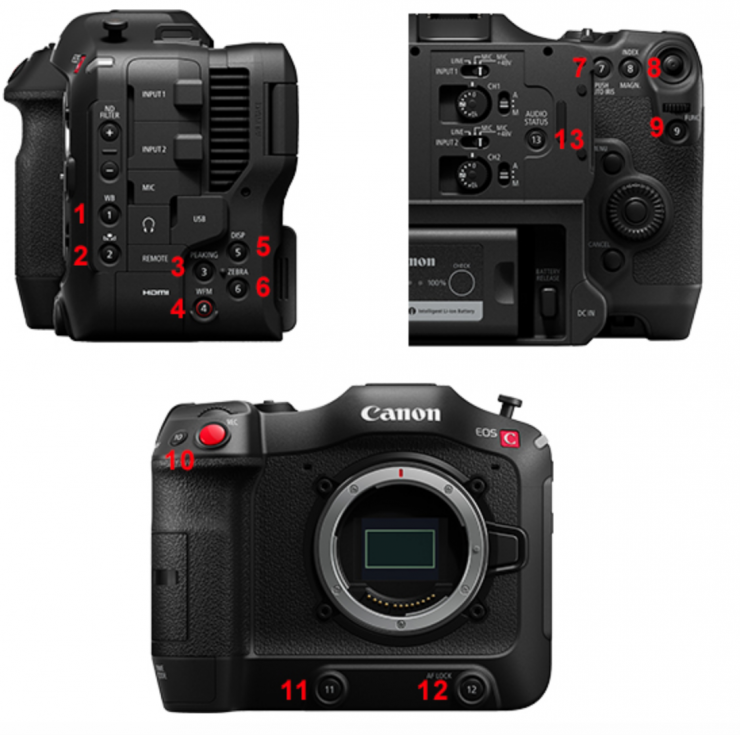
The C70 has a total of 13 assignable buttons. I found them too very helpful, and you have an option to assign them. I never liked to change the buttons with markings on the body, such as the Waveform button with the WFM. It would be confusing. With that said, Canon did an excellent job with a lot of buttons and options.
Below is a full list of what can be assigned
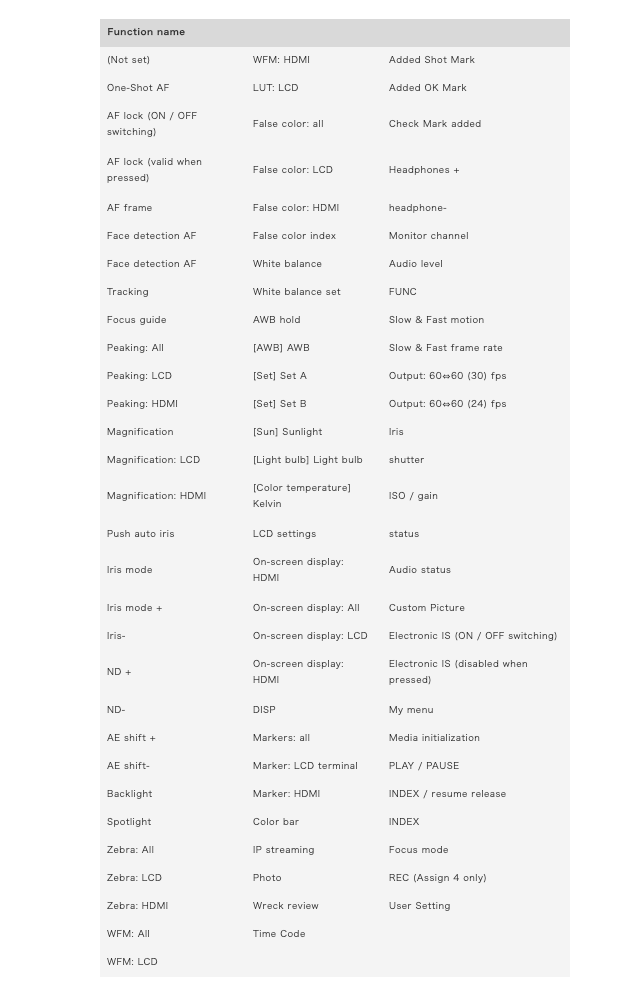
Monitoring – Articulating LCD Screen Only
The C70 doesn’t have a built-in EVF, and that could be an issue, at least it is for me. I would happily pay a little extra and have a slightly larger body to have one instead of adding one and dealing with powering it. Instead, the C70 uses a fully articulating LCD screen with a 3.5-inch (8.8 cm diagonal) color LCD with a 16:9 aspect ratio. It has approx. 2,760,000 dots (1280 x RGB x 720), and a 100% field of view ratio. It also features touch screen operation.
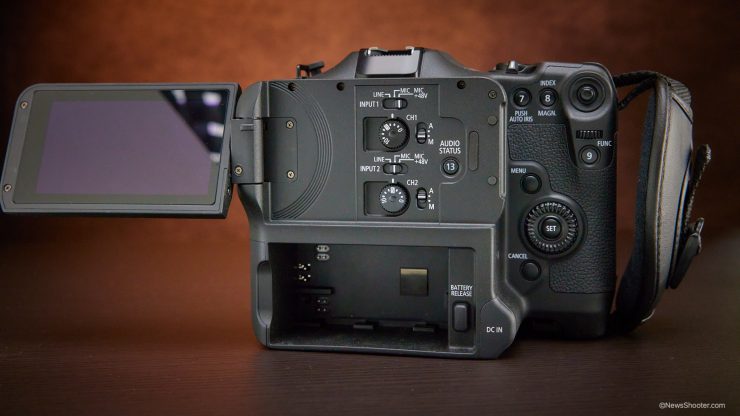
As for the size, I have a tough time depending on a 3.5″ screen for focusing, but the image is good. The other EVF-less camera I have used is the BMD Pocket 4K. While the screen is much bigger, it didn’t work in the sun, and it doesn’t articulate.
Canon cameras have a huge advantage as the Dual Pixel AF is very good so this takes one of the biggest issues away somewhat as focusing with the touch screen works very well. With that said, it’s fatiguing to looking at such a small screen for longer periods of time.
Touch Control
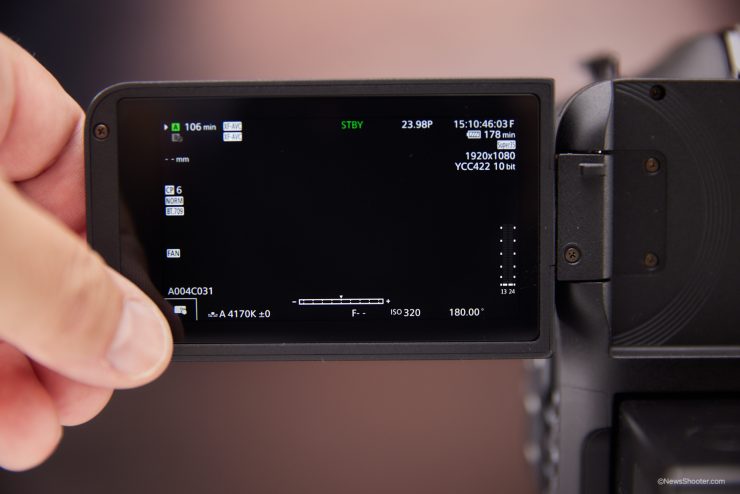
The touch screen is a good one. On the bottom of the LCD screen is a quick access menu that includes the most used settings. It works really well. You tap the corner, and the menu appears. It doesn’t take up a lot of room or block the image. It’s very handy. When you make the changes, a simple tap and it hides.
Touch Screen Options
- Quickly access menus for recording settings such as file format and resolution with a single touch.
- Change the amount of ND being used.
- Move from screen to screen quickly by swiping between pages.
- Intuitively set parameters with touch and swipe to change settings, such as ISO/Gain, color temperature, or aperture.
- Peaking, zebra display, and other screen display settings can be brought up all at once with one button.
Powering the C70
If you’re a C200, C300 MII, or C500 MKII, you will be happy to know the C70 uses the same BP-A30/BP-A60 batteries. You can record for around 200 minutes on a single BP-A30 battery and for around 400 minutes on a single BP-A60 battery. The BP-A60 battery retails for $429 US.
Another option is the Core SWX Nano-C98 battery with a similar capacity as the larger BP-A60 and includes a D-Tap and USB out for powering accessories. This is how I powered the affordable PortKeys LEYE EVF.
In & Out Features
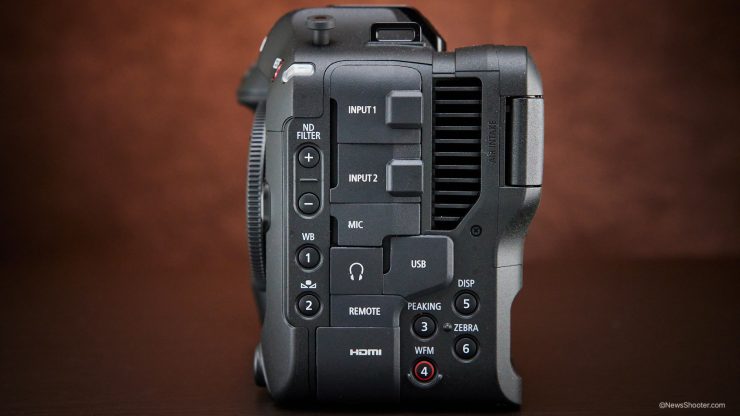
The C70 has limited space on the compact body for IO, so Canon had to make some decisions on what it has, and I think they did a great job adding crucial inputs to separate it from a hybrid camera such as two channels of mini XLR and 3.5mm inputs and full-size HDMI. Missing is an SDI port.
While the C70 doesn’t have everything you would find on a mid-tier digital cinema camera, Canon has packed in quite a few input and outputs for this size camera.
C70 I/O
- (2) 3-pin mini XLR
- (1) 3.5mm mic input
- Headphone jack
- USB Type-C
- Remote terminal
- Fullsize HDMI output (Type-A)
- Timecode in/out
Audio Options
Mini XLR
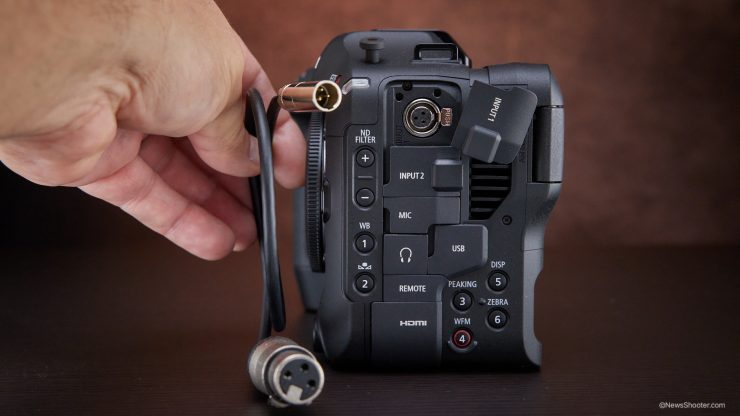
The mini XLR is a great option as it delivers the same balanced audio a full-size XLR gives only takes up a fraction of space on the camera. There is no downside other than you will end up either using a mini to full XLR adapter or get longer cables with the mini XLR on one end. I had a couple of 2-foot cables from the BMD Pocket I had, and they work perfectly. The two Mini XLR terminals provide +48-volt phantom power.
As for Mini XLR cables, if you don’t like the short cable idea, Kondor Blue makes three different lengths. 5′, 16′ and 25′.
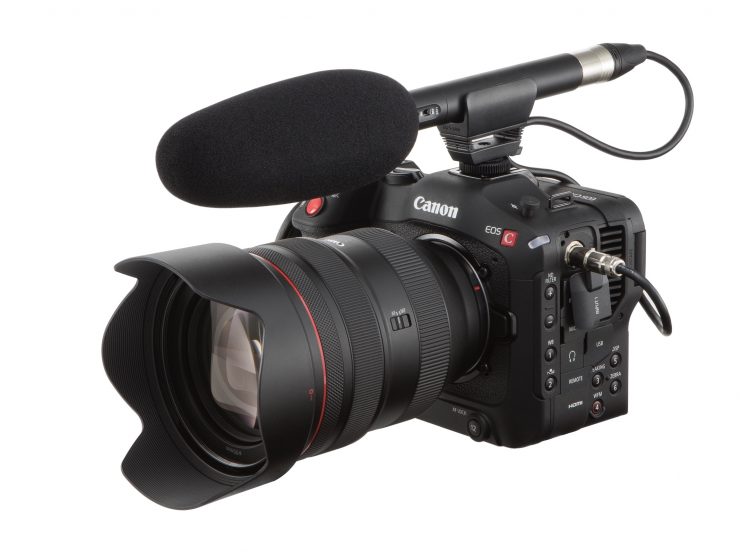
3.5mm Mic Input
The 3.5mm is set as dual mono, and like many 3.5mm inputs, it does have a small amount of voltage but not phantom power.
All the controls for the 3.5mm mic input are in the menu. This isn’t ideal as it does take a few steps to access it.
Most 3.5mm microphones use the TRS two-channel or stereo-type plug. The audio will get sent to both channels 1 & 2. The C70 has the option to change the level of the two channels independently. This would be great to set up as a safety track with one channel set lower in case the audio is set to hot.
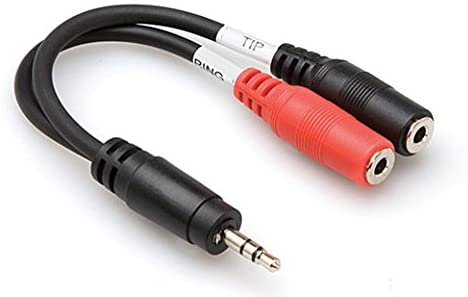
If you use a 3.5mm splitter, you can run two inputs that are split and run another microphone or a set of compact wireless systems like the Rode Wireless Go. This gives the C70, in essence, four channels of separate audio.
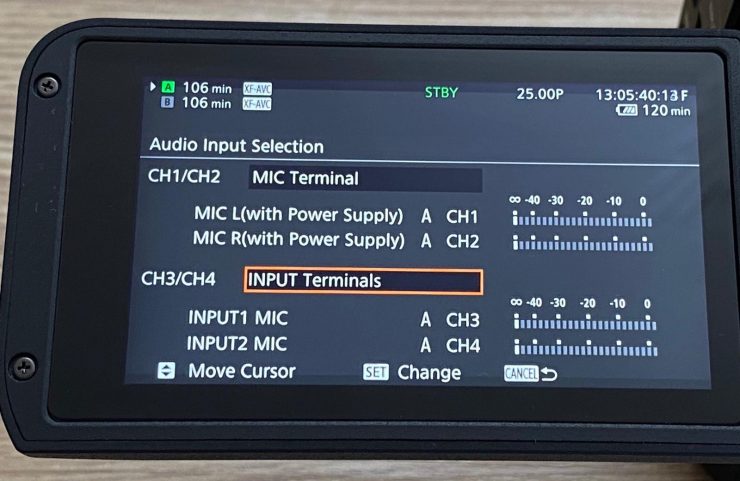
The camera has two built-in scratch mics, but you have to give up either the XLR or 3.5mm input. This is set in the menu.
Since real estate is hard to come by on the C70, the audio controls are under the LCD screen. I’ll take analog dials and buttons over menu settings for audio any day, so I can’t complain too much about the placement; however, it covers the controls if the LCD is closed. Knowing this, I keep the LCD open during interviews or when shooting for audio in general.
The placement on the back is user-friendly, as I was able to make adjustments while recording. With the clamshell design of the C300 MKII, you have to get on a step stool to see the dials since it’s on top of the camera. Having them at eye level is so much better.
You have a level dial for channels 1 & 2 as well as a switch for Line/Mic/Mic +48. You can choose to set either channel to auto or manual.
The Audio Status Button is a quick way to see what the camera settings are for audio. This is very handy. Not only do you see how the inputs are set, but you can also make changes to them by tapping the SET button. It then goes right to the audio settings. Nifty!
Monitoring The Audio
You have several different configurations to choose from when it comes to monitoring the audio. Canon gives you a lot of options, from the simple split 1 & 2 channels to having all four channels separated out in both headphones.
If you set an assignable button to [Headphones +] or [Headphones –], you can press the button to adjust the headphone volume without using the menu. The downside is you lose two precise shortcut buttons.
Timecode In & Out
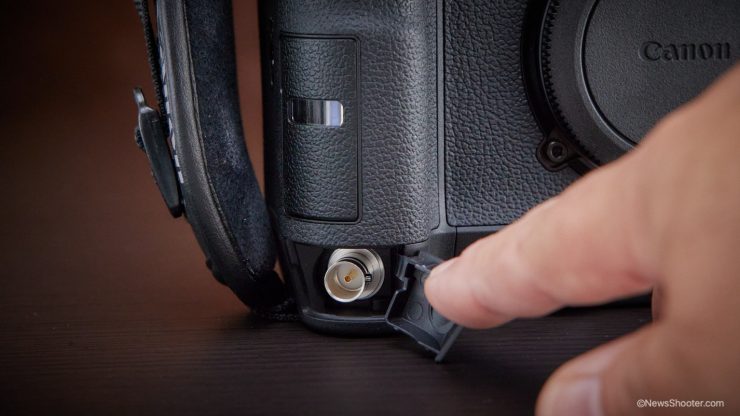
If you are going to use a C70 in a multi-cam set up the ability to jam sync timecode is very important. The C70 can send and receive an SMPTE-standard LTC timing signal. When an external time code signal is received, the C70’s own time code will be synchronized to it, and the synchronization will be maintained even if you disconnect the cable from the TIME CODE terminal.
Performing any of the following actions while the cable is not connected will cause the synchronization to be disrupted; the correct time code will be restored once you reconnect the cable.
- Turning the camera on/off
- Switching to MEDIA mode
- Changing the video configuration
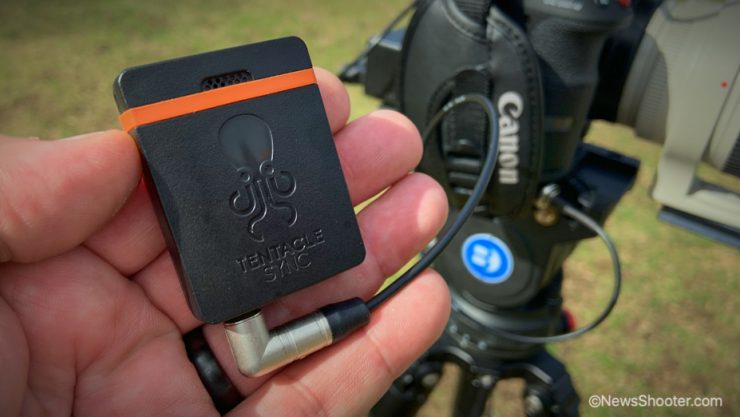
I used a Tentacle Sync to jam both the C300 MKII and the C70. workes flaws. Other TC jamming devices will also work.
Having two cameras match TC without worrying about sync over several hours is great as it makes matching the shots in a post a breeze.
Full-Size HDMI
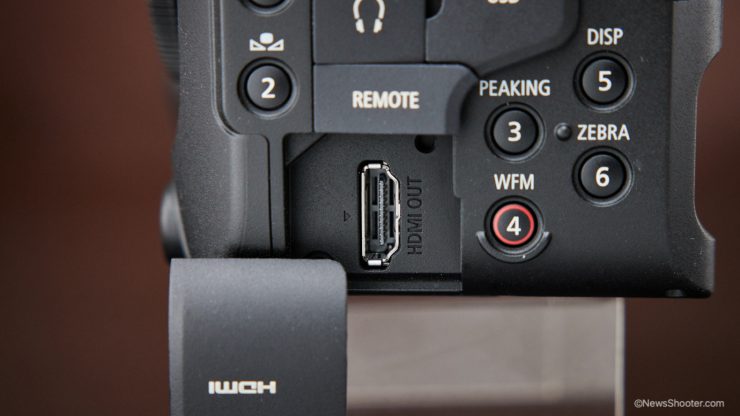
While HDMI seems to be the go too hardware for lower budget cameras, it would have been nice to have an SDI option. I get that the body is small and something has got to give, but a man can dream. At least the C70 has a full-size HDMI port instead of those pesky micro versions.
Built-in ND
Shooting outside and controlling the depth of field requires ND filters. Variable ND works okay, but nothing compares to a built-in ND on a Cinema Camera. It’s great that Canon was able to incorporate built-in ND into such a small camera. I think the size of the C70 is larger due to having ND, and I feel it’s well worth it.
This is a brand new ND system that was designed specifically to work with the C70. It offers up to 10 stops in its expanded mode. You can activate the ND via the touchscreen or ND buttons on the side of the camera.
S35 Sensor
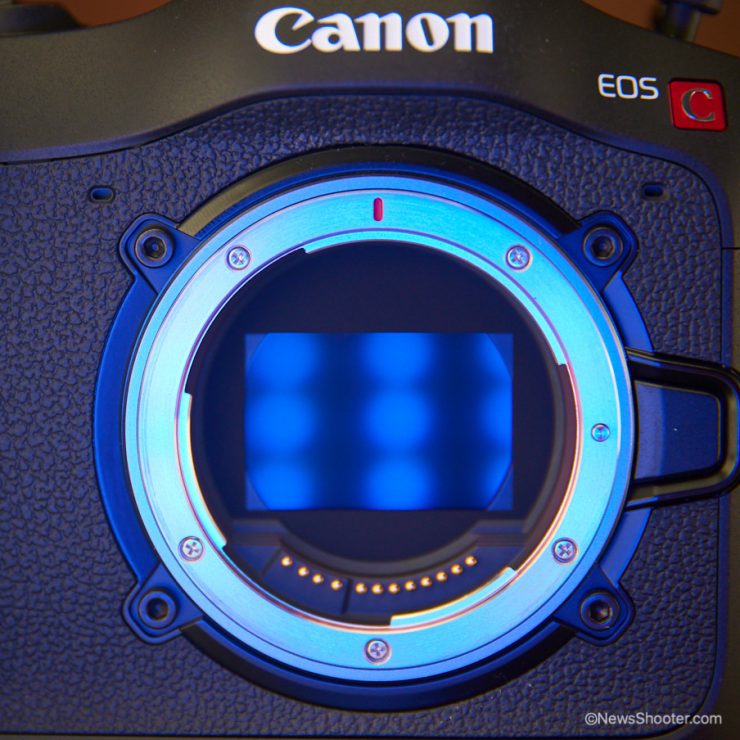
The Canon C70 uses the exact same Super35 26.2 x 13.8 mm CMOS sensor as the C300 Mark III and also utilizes the same DGO technology and a Digic DV7 image processor.
The sensor has a pixel pitch of 6.4 µm, and it has an effective resolution of 4096 x 2160 (8.85 MP).
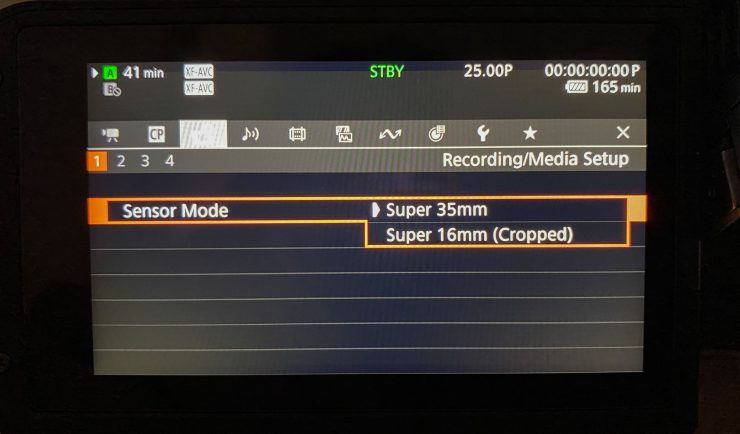
The sensor has two modes, Super 35mm, and Super 16mm (crop)
Crop Factors in Different Resolutions
Here are the various crop factors compared to a full-frame sensor when shooting in different resolutions
- 4K Super 35mm: 1.46x
- UHD Super 35mm: 1.53x
- 2K Super 16mm (cropped): 2.92x
- HD Super 16mm (cropped): 3.07x
The C70 red, green, and blue components have no algorithmic debayering processes. A parallel readout process within the image sensor separately extracts the four individual components, including the two spatially offset green components (green has twice as many spatial samples as the red and blue components). This approach avoids any of the reconstruction errors inevitably associated with algorithmic debayering.
Dual Gain Output
The DGO sensor produces images optimized for HDR by creating two images. One prioritizes highlights, and the other prioritizes shadows and dark areas. Canon states that this sensor is capable of 16+ stops of dynamic range with reduced noise in the shadows and improved low light performance. You will probably not notice a massive increase in dynamic range if you are still finishing in SDR. It is with HDR that DGO will be noticeable.
Noise is also greatly reduced because the Dual Gain Output signal is taken directly from the sensor and before any image processing occurs.
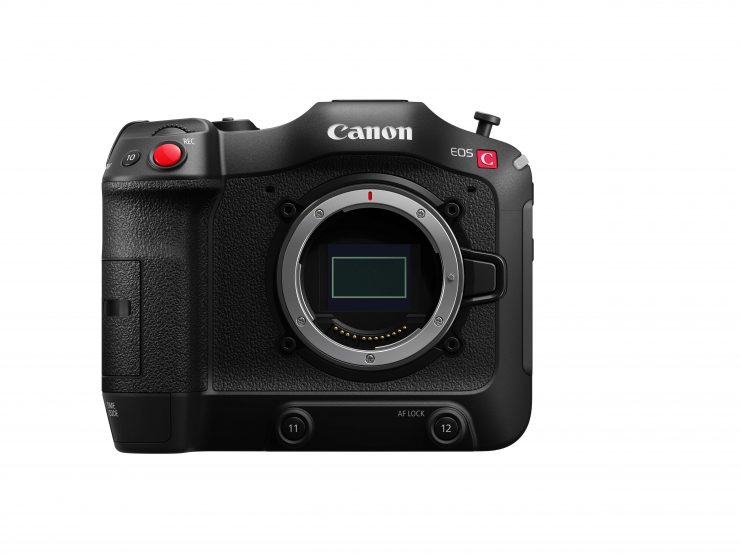
16+ stops of dynamic range is a very bold claim. If, in fact, the camera does have 16+ stops of actual dynamic range, that would give it the most dynamic range of any camera on the market. Of course, what is more important is where that dynamic range is being allocated.
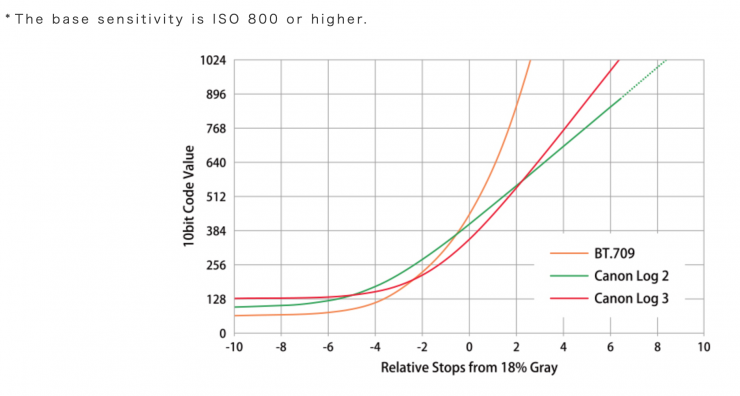
The DGO works across all ISO ranges on the camera. Canon says that the most dynamic range (16+ stops) can be achieved when shooting at 800 ISO in Canon Log 2. If you shoot in Canon Log 3, then the dynamic range drops to 14 stops. From what I have seen, if you move off the camera’s native ISO, the DGO isn’t as effective when shooting at higher ISO levels. It also appears that the extra dynamic range you are getting on the camera is coming below middle grey. If you look at images from the C300 Mark III, there didn’t seem to be any dynamic range improvement in the highlights if you compare it to the C500 Mark II. I expect the same to be true with the C70.
Now, there is a catch with this Dual gain Output system. It doesn’t work when you are shooting in frame rates above 60p in S35 4K. However, it does work when you are shooting in 2K Super 16mm Crop mode up to 180fps. This is not surprising because the amount of processing power to deal with two readouts at high resolutions and high frame rates would put a proportionally bigger load on the system.
You shouldn’t confuse Dual Gain Output with Dual Base ISO. Although it’s the same basic idea of having different readout calibrations, Dual Gain Output is much harder to do than Dual Gain ISO because that switches between the two. What ARRI and Canon are doing requires there to be a dual readout on every frame and then processing all of that on every frame.
Canon has also included an Auto ISO option in the C70. According to Canon, this is the first Cinema EOS camera to feature an Auto ISO capability. The Auto ISO can be set to either High or Low in the menu. For certain shooting applications, this is a nice feature to have, especially if you happen to be going from outdoors to indoors in one shot.
Dual Pixel CMOS AF
Canon’s Dual Pixel CMOS AF uses every pixel on the imaging sensor to detect focus and capture actual image information to achieve high precision focusing and high image quality.
DGO (Dual Gain Output) and Dual Pixel CMOS AF work together just like they do on the C300 Mark III.
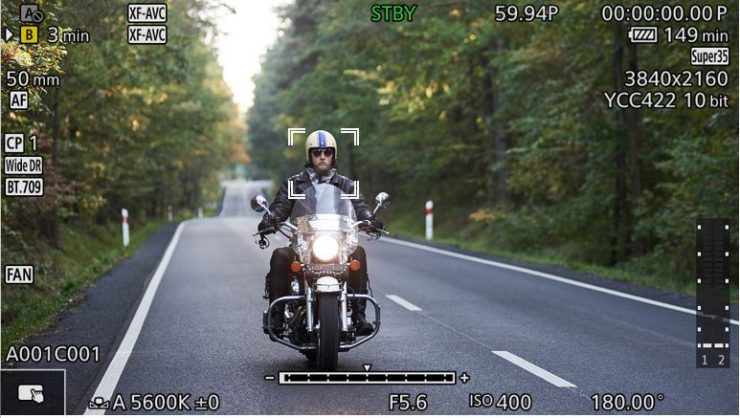
There are various AF modes, including fast One-Shot AF and Continuous AF, available within 80% of the frame both horizontally and vertically with touchscreen selection and control. Tracking AF can also automatically track a selected object even as it moves.
Two face detection modes (Face Priority and Face Only) can automatically detect and track a selected face within the frame or prioritize it over a pre-selected focus point. For my shoot, I had several kids in the frame talking at different random times. Each kid had a box around their face, and I used the toggle to move the focus priority. It was perfection!
Like on many Canon EOS cameras, there is a Dual Pixel Focus Guide that enables users to manually hold and control critical focus with confidence by adding front/back focus indicators.
AF issues in lowlight
Something to note. I have heard that the C70 AF doesn’t perform well in lowlight situations or at least compared to other Cinema EOS cameras. I didn’t have a chance to test this, and I don’t shoot in very low-light situations, so the issue didn’t come up for me. Something to think about, and if it is an issue, hopefully, Canon will fix it with an update.
Dual Pixel CMOS AF EOS iTR AF X

Canon has taken its Dual Pixel CMOS AF a step further on the C70. For the first time in the Cinema EOS System, the C70 features EOS iTR AF X. iTR stands for Intelligent Tracking and Recognition. This is the exact same system that is found in the Canon 1DX Mark III.
By utilizing deep-learning algorithms, the system can track a subject’s head with excellent accuracy regardless of whether they are tuned towards the camera on not. Autofocus is getting crazy good and constantly improving. Paired with a modern lens, the results are magical.
C70 Compared to C300 Mark III
The C70 is basically a smaller C300 MKIII as it uses the same sensor and processor. Unfortunately, no Cinema RAW Light option won’t be added with an update since the C70 uses SD Cards instead of the CFExpress that Cinema Raw Lite requires.
Side-by-Side Comparison of C300 MKIII & C70
| CANON C300 Mark III | CANON C70 | |
| Sensor | 26.2 x 13.8 mm (Super35) | 26.2 x 13.8 mm (Super35) |
| WEIGHT | 1.77 kg (3.9 lb) | 1.17 kg (2.58 lb) |
| MOUNT | Canon EF | Canon RF |
| BUILT-IN ND | Yes | Yes |
| HDMI | HDMI 2.0 | HDMI 2.0 |
| SDI | Yes: 1 x BNC (12G-SDI) Output 1 x BNC (12G-SDI) Monitor Output | No |
| TIMECODE | Yes: 1 x BNC Timecode Input 1 x BNC Timecode Input/Output | Yes |
| EVF | Yes | No |
| AUDIO | 2 x 3-Pin XLR Mic Level (+48 V Phantom Power) Input 1 x 1/8″ / 3.5 mm Stereo Mic Level Input 1 x 1/8″ / 3.5 mm Stereo Headphone Output | 2x Mini XLR (+48 V Phantom Power) Input 1x 3.5mm microphone jack 1 x 1/8″ / 3.5 mm Stereo Headphone Output |
| INTERNAL RECORDING | Cinema Raw Light 10/12-bit 4096 x 2160 2048 x 1080 (cropped) XF-AVC 4:2:2 10-bit 4K (4096 x 2160) 23.98/24/25/29.97/50/ 59.94/100/119.98 UHD (3840 x 2160) 23.98/24/25/29.97/50/ 59.94/100/119.98 2K 2049 x 1080) 23.98/24/25/29.97/50/ 59.94/100/119.98/180 HD (1920 x 1080) 23.98/24/25/29.97/50/ 59.94/100/119.98/180 XF-AVC (Long GOP) 4K (4096 x 2160) 23.98/24/25/29.97/50/ 59.94/100/119.98 UHD (3840 x 2160) 23.98/24/25/29.97/50/ 59.94/100/119.98 2K 2049 x 1080) 23.98/24/25/29.97/50/ 59.94/100/119.98/180 HD (1920 x 1080) 23.98/24/25/29.97/50/ 59.94/100/119.98/180 XF-AVC (Long GOP) Proxy 4:2:0 8-bit 2K (2049 x 1080) 23.98/24/25/29.97/50/ 59.94/100/119.98/180 (35 Mbps) HD (1920 x 1080) 23.98/24/25/29.97/50/ 59.94/100/119.98/180 (24 Mbps) 1280 x 720 23.98/24/25/29.97/50/ 59.94/100/119.98/180 (17 Mbps) | XF-AVC H.264 Intra 4:2:2 10bit 4096 x 2160 up to 29.97 3840 x 2160 up to 29.97 2048 x 1080 up to 59.94 1920 x 1080 up to 59.94 XF-AVC H.264 Long GOP 4:2:2 10bit 4096 x 2160 up to 59.94 3840 x 2160 up to 59.94 2048 x 1080 up to 59.94 1920 x 1080 up to 59.94 XF-AVC HFR (Special Rec) H.264 Long GOP 4:2:2 10bit XF-AVC H.264 Long GOP 4:2:2 10bit 4096 x 2160 up to 119.88/120P 3840 x 2160 up to 119.88/120P 2048 x 1080 up to 1920 x 1080 up to 179.82/180P MP4 H.265 and MP4 H.264 recording modes are also available |
| RECORDING MEDIA | 2 x CFexpress Card Slots 1 x SDXC Card Slot | 2x SDXC Card Slots |
Matching the C70 with the EOS R5
You would think matching cameras made by the same company would work right out of the box. and with the C70 and C300 MKIII, it’s a breeze since they use the same sensor and color science, but it’s not that simple with other models, and trust me I wish It was.
The C70 and EOS R5 have a similar look, but both cameras don’t have similar settings to match them. it does get close, but certain colors like Cyan, Yellow and blue are different. That is a lot since there are six primary colors.
R5 Neutral—–C70 BT.709 Normal / BT709 Neutral
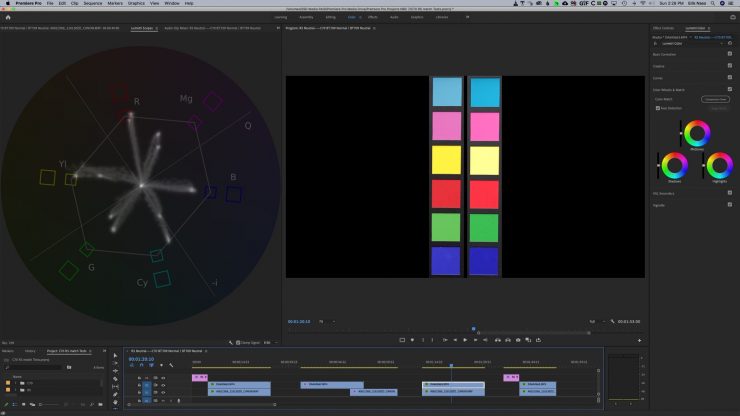
I tried to use a baked-in look first on both cameras as I do like to use Rec.709 for low contrast shooting environments where their dynamic range isn’t needed. It’s also great for handing footage over to any editor and not worry if they color grade or are familiar with color grading Log footage.
I was surprised how easy it is to match the cameras shooting Rec.709 with both using “Neutral.” Clog also works well even though the R5 only has Clog and not Clog 2 or Clog 3.
This combo worked really well, and the only color that needed to be adjusted was the blue. It required more Magenta, and the hue needed to be deeper.
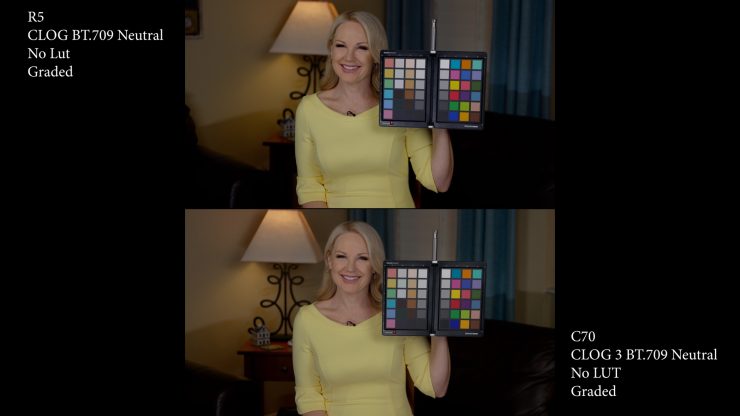
I tried Clog 2, Clog3 with C Gamut, and Rec.709, and after applying the Canon LUT, they all normalized very similarly, with the blue channel being deeper and needing Magenta added. Outside of that, the cameras will match pretty well. I highly recommend shooting a color chart and white balancing both cameras at the same time to ensure a better match in post.
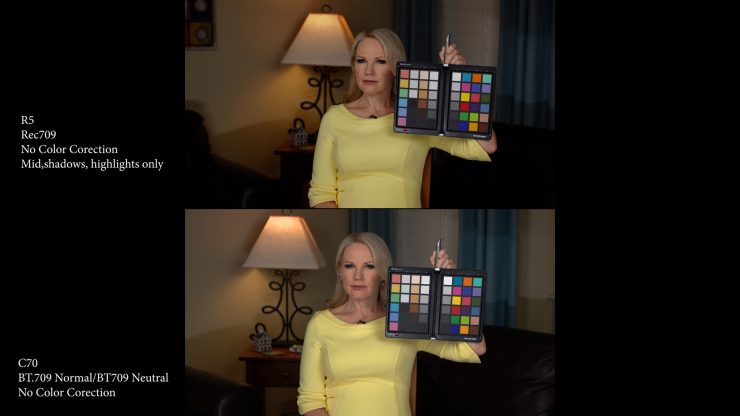
To the naked eye, I would say the C70 color looks more accurate than the EOS R5. Canon should have a firmware update coming for the R5, and I hope they decide to tweak the color a little to give an even better match. Adding Clog 2 and Clog 3 with C Gamut would be great as that would make it [potentially a perfect match.
I know many want Canon Raw Lite on the R5, giving you the most flexibility in post since you can choose the Clog option and color space in post.
The good news here is you can easily use the R5 with the C70 with minimum corrections to match them. Just use similar settings for both cameras, and you are good to go!
Matching the C70 with C300 MKII
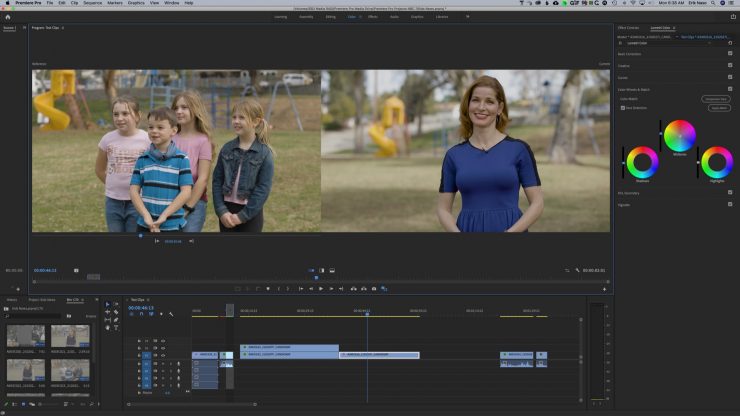
For a two-camera shoot, the C70, for the most part, is very easy to match with the C70. I shot both cameras in Clog2. In the sample above, I used levels to adjust the blacks and highlights. The C300 MKII has a touch greener, so I moved it a bit towards blue, and it looks pretty good. Add back saturation to both, and that’s it.
One thing with Canon color is it tends to be very similar over the years while Sony has made big changes. The improvements that Sony has made are good ones as their color isn’t my favorite.
RF Mount & New EF-EOS R 0.71x Speedbooster
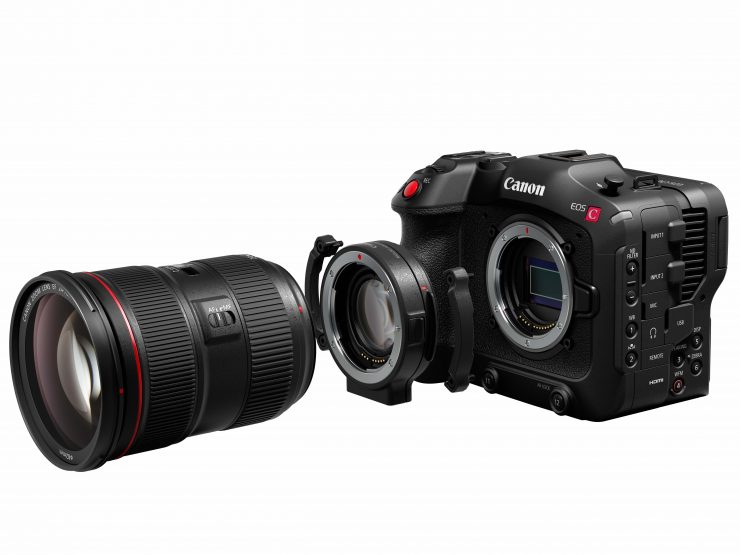
Unfortunately, I wasn’t able to get the Canon Mount Adapter EF-EOS R 0.71x for this review. It’s very cool that Canon decided to make a focal reducer so we can use the vast lineup of EF lenses on the S35 sensor and have that full frame field of view with an extra stop of light in brightness to boot. For example, an F4 lens using the adapter will give you the same amount of light as an F2.8 lens. Not bad, right?
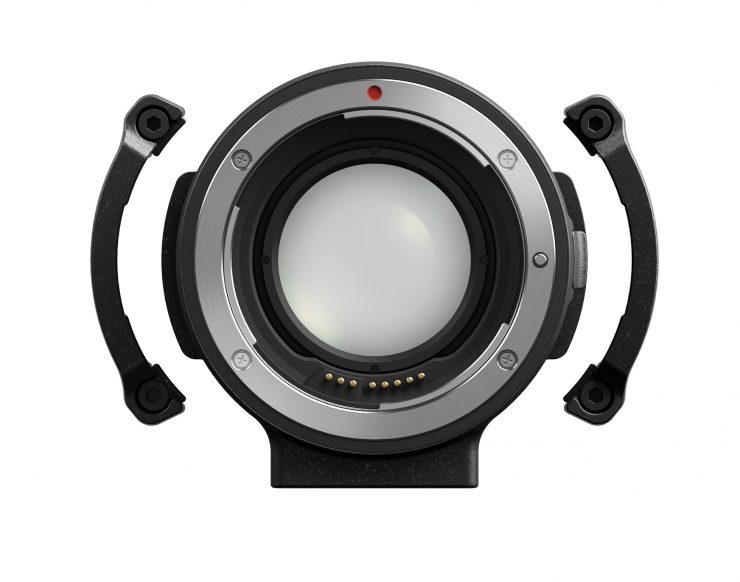
The EF-RF “Speedbooster” creates a 0.71x wide optical conversion. It fully supports CMOS AF and optical correction with Canon EF lenses. It will also pass through and display f-number, focal length, and lens metadata.
I have the Canon EF to RF adapter for my EOS R5, and it is great. I’ve never used an adapter that works so well. This makes sense since the adapter is passing through Canon’s own technology as opposed to, say, a Canon EF on a Sony camera. The adapter acts like a translator, and in most cases, it’s very hit and miss.
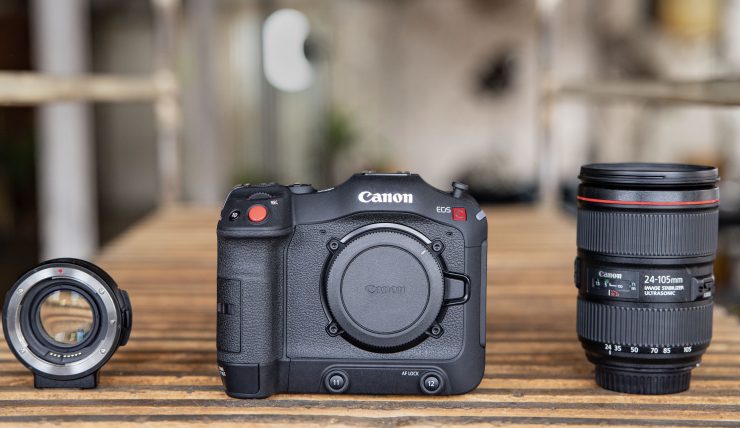
Something to keep in mind about Focal Reducers is they don’t change the depth of field. While you get an extra stop of light, it doesn’t make that background look like the same lens at 2.8 on a full-frame sensor.
The adapter mounts like any other adapter; however, if you are running heavier lenses, it can also be attached via four screws to the body of the C70. If you are going to be swapping between RF and EF lenses frequently, you probably wouldn’t want to screw in the EF-EOS R 0.71x mount.
There is currently a catch with the adapter. As of this moment, only the following Canon EF lenses can be used:
- Canon EF 16-35mm F2.8L III USM
- Canon EF 24-70mm F2.8L II USM
- Canon EF 24-105mm F4L IS II USM
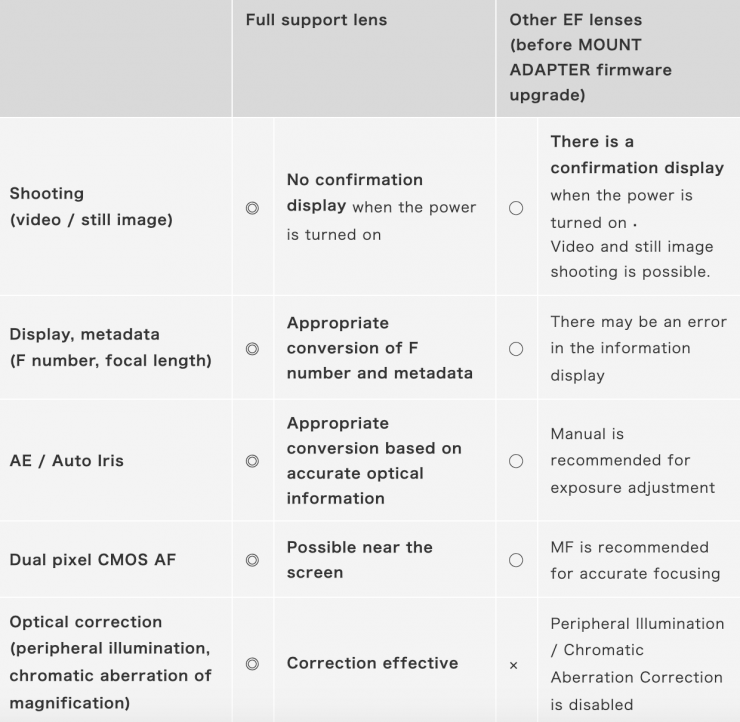
However, Canon’s entire range of EF lenses will be compatible with the EF-EOS R 0.71x mount adapter through the release of free firmware updates across 2021 that will enhance the communications and functions between the camera and lenses.
The adapter will not work with the EOS R5, R6, or any other current Canon RF mount camera.
The EF-EOS R 0.71x retails for $599.99 USD.
Resolution, Framerates & Codecs
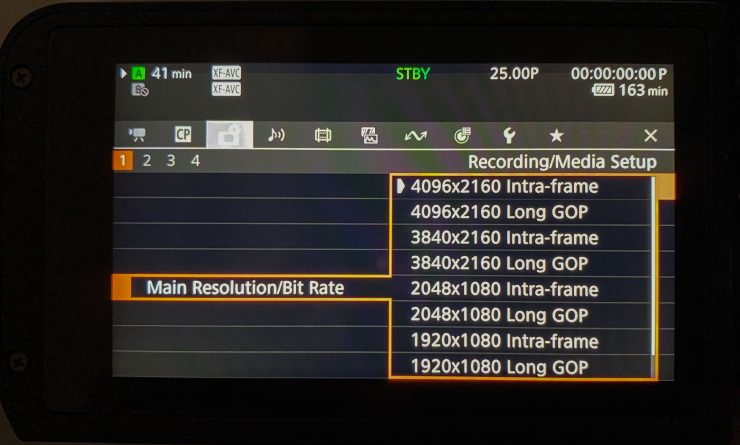
Image copyright: Dave May 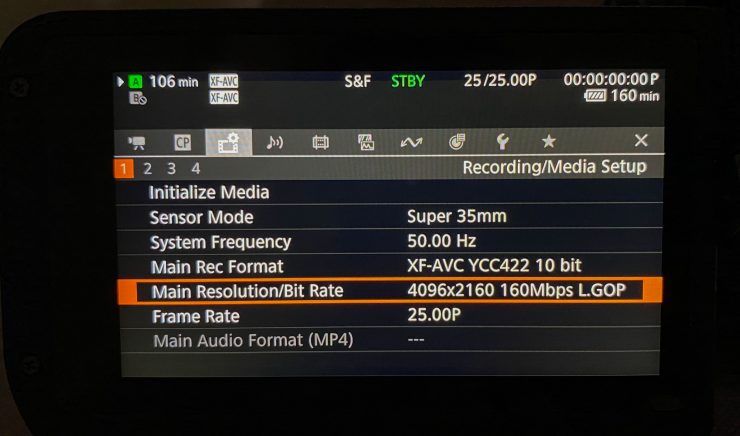
Image copyright: Dave May
The C70 is capable of recording in resolutions up to 4K DCI (4096 x 2160) and in frame rates of up to 120p. In 2K or HD, you can record up to 180p.
| FORMAT | SAMPLING | RESOLUTION | MAX. FRAME RATE |
| XF-AVC H.264 Intra | 4:2:2 10bit 410Mbps 4:2:2 10bit 310/160Mbps | 4096 x 2160 3840 x 2160 2048 x 1080 1920 x 1080 | Up to 29.97/25P Up to 59.94/50P |
| XF-AVC H.264 Long GOP | 4:2:2 10bit 260/160Mbps 4:2:2 10bit 50Mbps | 4096 x 2160 3840 x 2160 2048 x 1080 1920 x 1080 | Up to 59.94/50P Up to 59.94/50P |
| XF-AVC HFR (Special Rec) H.264 Long GOP | 4:2:2 10bit 4:2:2 10bit | 4096 x 2160 3840 x 2160 2048 x 1080 1920 x 1080 | Up to 119.88/120P Up to 179.82/180P |
| XF-AVC Proxy H.264 Long GOP | 4:2:0 8bit 35Mbps/24Mbps | 2048 x 1080 1920 x 1080 | Up to 59.94/50P |
| MP4 H.265 Long GOP | 4:2:2 10bit 225Mbps | 4096 x 2160 3840 x 2160 | Up to 59.94/50P |
| MP4 HFR (Special Rec) H.265 Long GOP | 4:2:2 10 bit 4:2:2 10bit | 4096 x 2160 3840 x 2160 2048 x 1080 1920 x 1080 | Up to 119.88/120P Up to 179.82/180P |
| MP4 H.264 Long GOP | 4:2:0 8bit 150Mbps | 4096 x 2160 3840 x 2160 | Up to 59.94/50P |
| MP4 HFR (Special Rec) H.264 Long GOP | 4:2:0 8bit 4:2:0 8bit | 4096 x 2160 3840 x 2160 2048 x 1080 1920 x 1080 | Up to 119.88/120P Up to 179.82/180P |
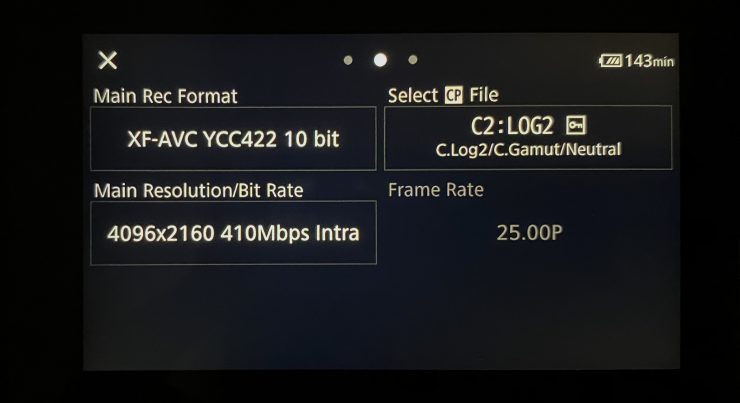
The C70 can record 4K DCI or UHD in 4:2:2 10-bit up to 30p in XF-AVC H.264 Intra, and 4K DCI or UHD in 4:2:2 10-bit in XF-AVC H.264 Long GOP.
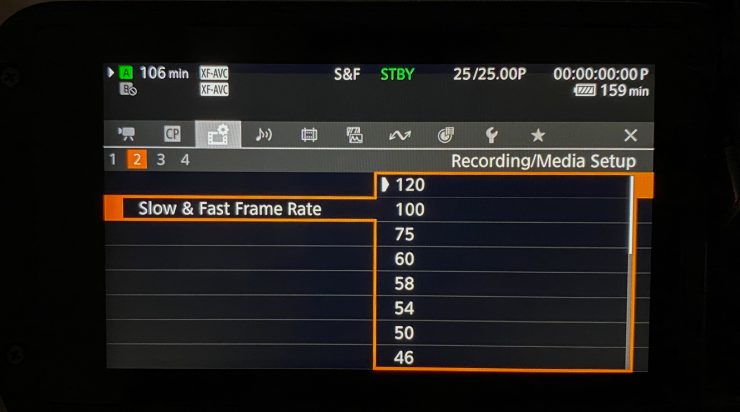
Image copyright: Dave May 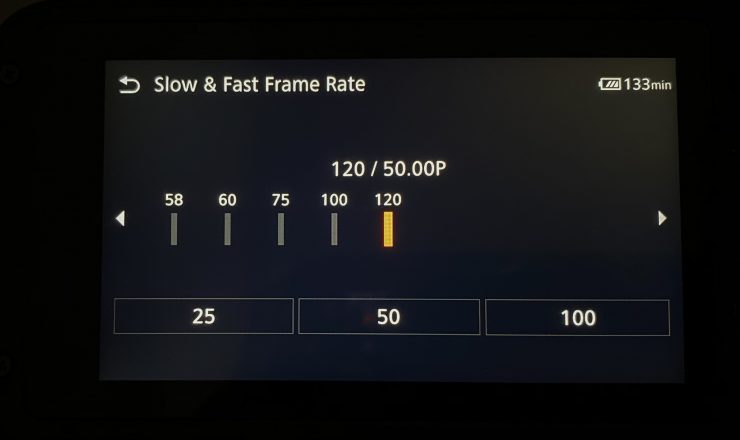
Image copyright: Dave May
It can also record 4K DCI or UHD at up to 120p in 4:2:2 10-bit XF-AVC HFR (Special Rec) H.264 Long GOP.
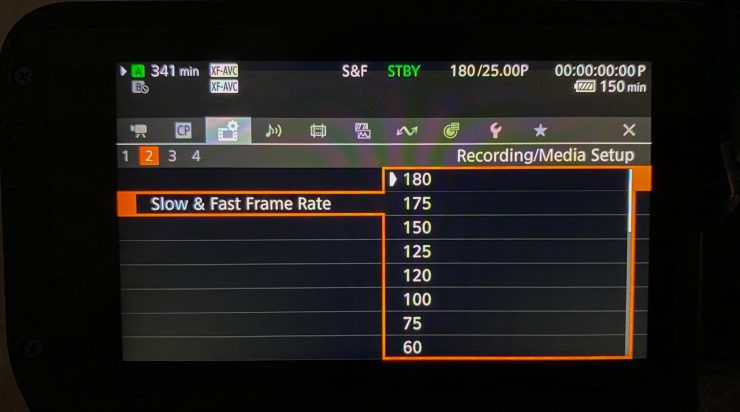
Image copyright: Dave May 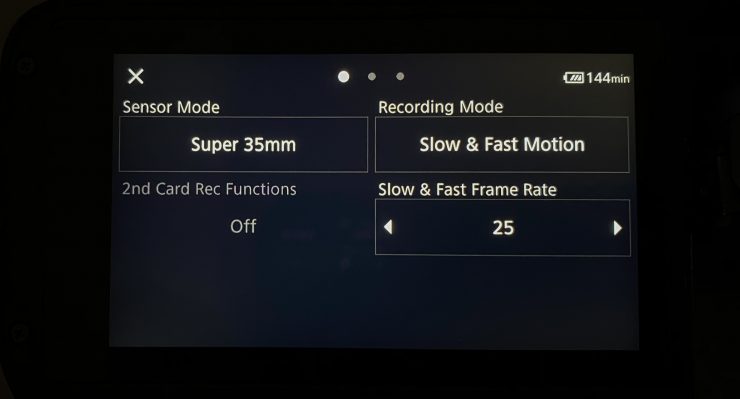
Image copyright: Dave May
In 2K or HD, you can record up to 180p in 4:2:2 10-bit XF-AVC HFR (Special Rec) H.264 Long GOP. Please note the camera can shoot in S35 mode in 4K DCI, UHD, 2K, and HD.
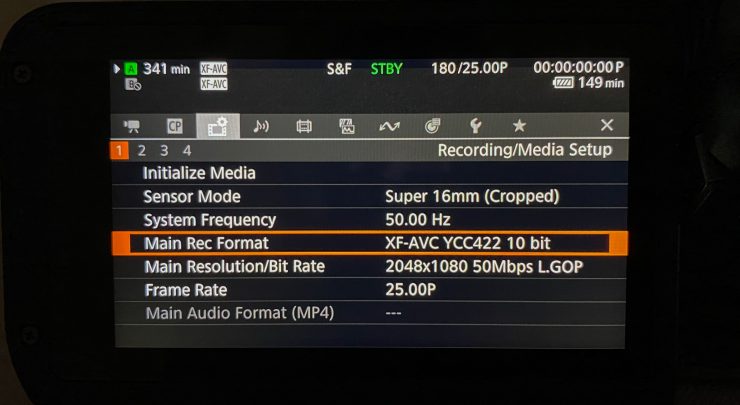
Image copyright: Dave May 
Image copyright: Dave May
As I mentioned earlier, there is also a Super 16mm cropped mode that you can shoot in. This results in a crop of 1.92x when shooting in 2K or 3.07x when shooting in HD.
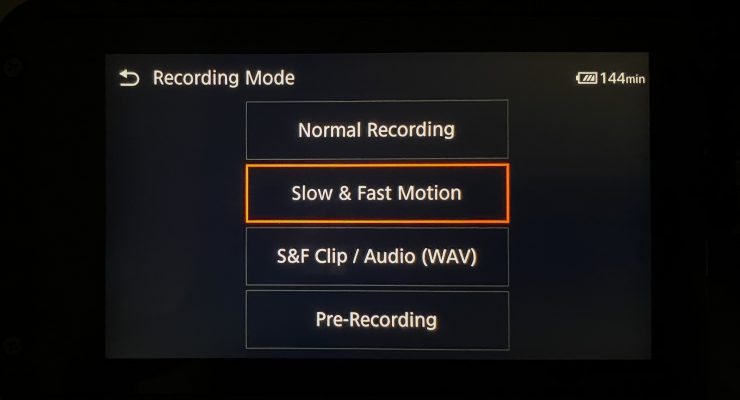
What is interesting to see is that Canon has enabled simultaneous audio recording when shooting high frame rates. The audio gets recorded in a separate file from the video. The file format it records in is BWF (.WAV extension). This is a great feature and something that shouldn’t be overlooked.
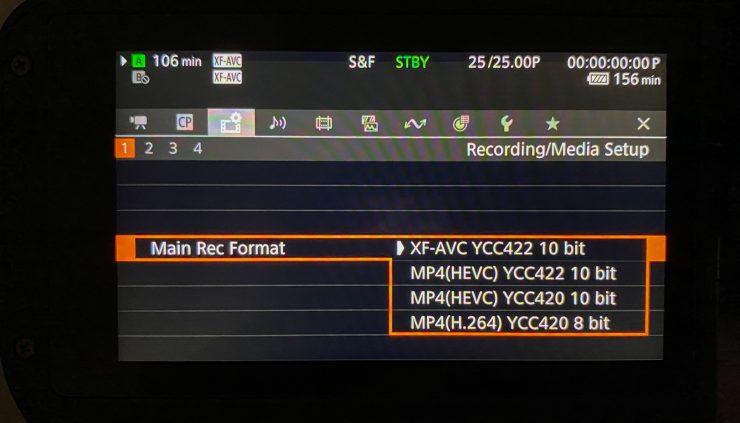
As far as codec choices are concerned, you can choose from XF-AVC Long GOP, XF-AVC Intra, MP4 H.265 Long GOP, or MP4 H.264 Long GOP.
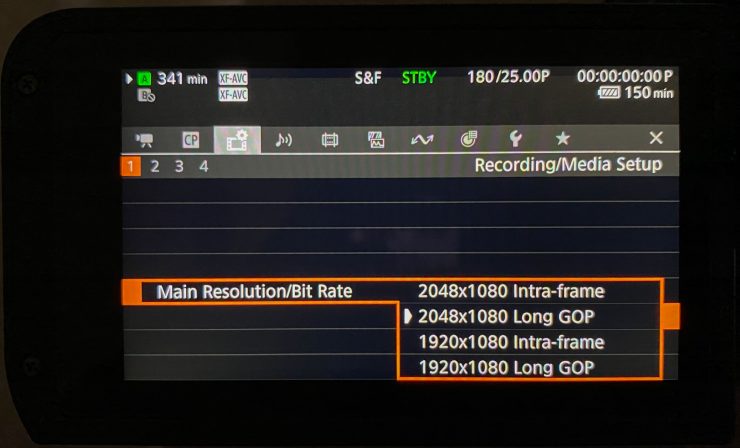
So what is the difference between Intra and Long GOP codecs? I’m glad you asked! An Intra-based codec compresses the images frame by frame. This means each frame is decoded and encoded separately. Long GOP is an inter-frame-based codec; as its name suggests, it detects the differences in frames by referring to the previous and subsequent frames. It isn’t saving the complete information from every frame like an Intra codec; instead, it is literally just saving the differences it sees between the changing frames. In plain English, it is basically making predictions based on changing frames and not decoding and then encoding every frame. Long GOP codecs are used because they don’t take up much card space, and they allow you to record for long periods of time.
There are no RAW recording options available on the C70, either internally or externally. When I asked why I was told by Canon that if people want to record RAW, then there is the C200. It is a little strange that the lower-priced R5 can record RAW, but this camera can’t.
At this time, there are no plans to implement external RAW recording in the C70. Internal RAW recording would not be possible using the current SD media the camera takes.
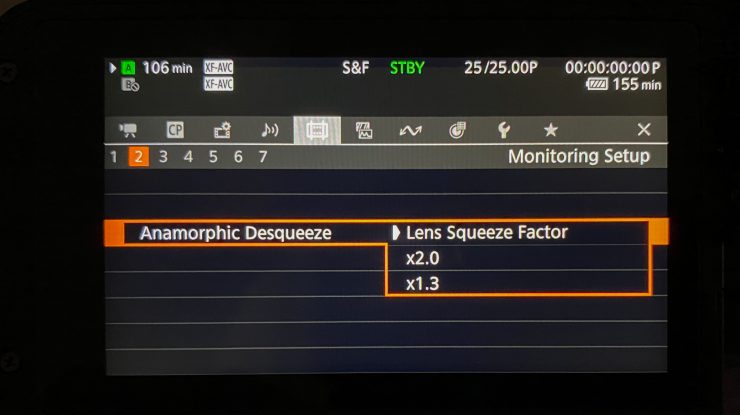
Image copyright: Dave May 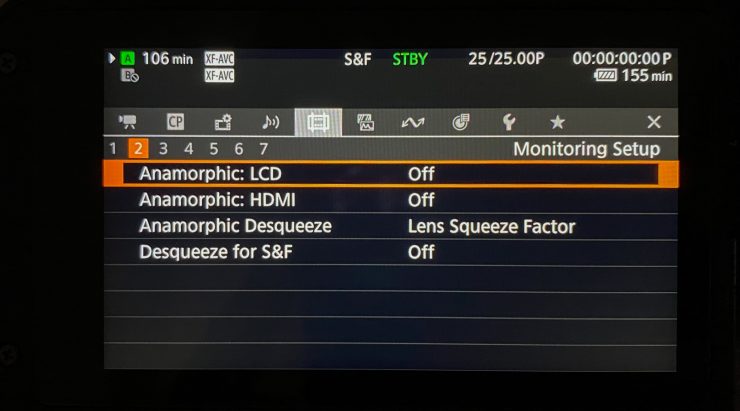
Image copyright: Dave May
The camera does have the ability to view de-squeezed anamorphic images, but there are no anamorphic modes. You can also output a de-squeezed image over HDMI.
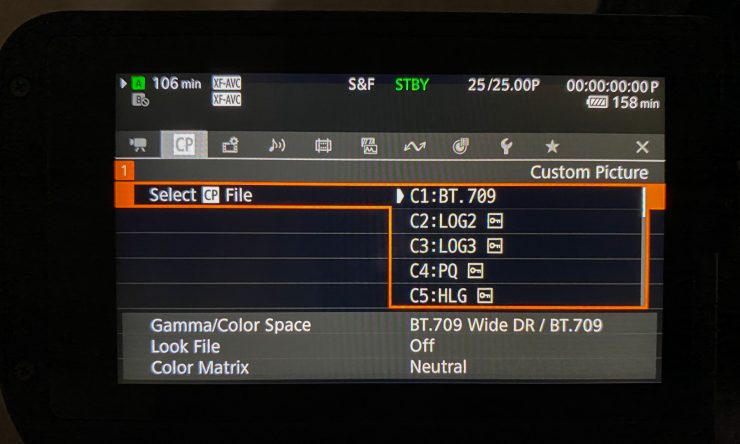
The C70 allows you to shoot in:
- BT.709 (BT.709 Wide DR/ BT709)
- Canon Log 2 (C.Gamut)
- Canon Log 3 (C.Gamut)
- PQ (PQ/ BT.2020)
- HLG (HLG/ BT.2020)
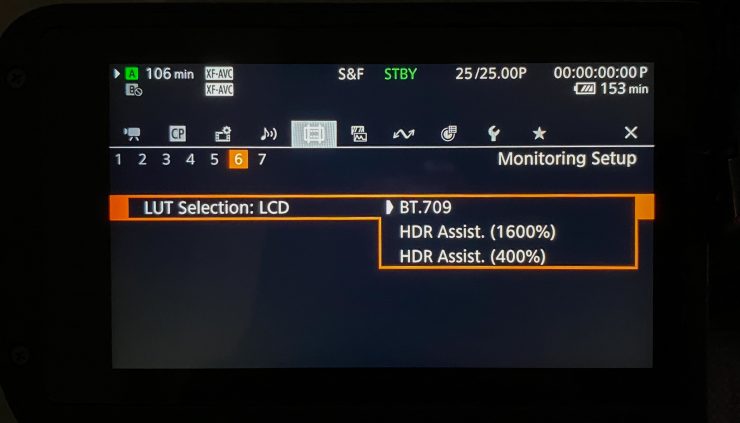
Image copyright: Dave May 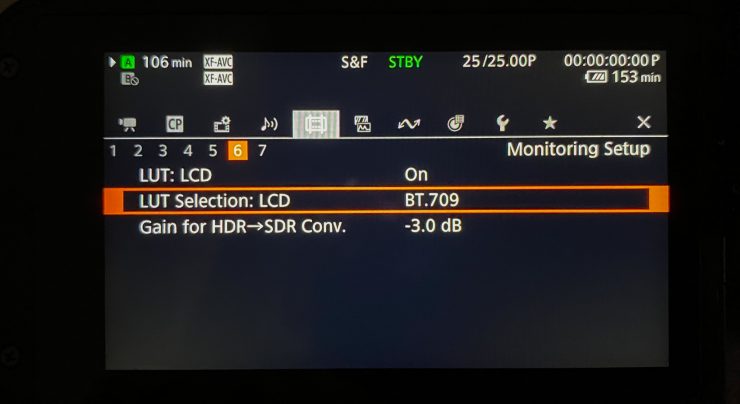
Image copyright: Dave May
The C70 does have some in-built LUTs, but you can’t load up or import any custom LUTs of your own. However, according to Canon Japan, there is a “Look File” for creating custom picture profiles. This allows you to import a .Cube format 3D LUT into the camera and apply the captured 3D LUT for recording. This makes it possible to record with the intended look even in workflows that do not do color grading.
Dual SD Card Slots
With a dual card slot, you have some great options. The camera can use SD UHS-II cards. The media card slots are located on the front right-hand side of the camera.
The C70 can simultaneously record the same resolution and frame rate to two cards at once, or simultaneously record different formats at the same time, or do relay recording. The C70 can also record proxies on either the main card or to the second. Options are great, and I like that you have them with the C70.
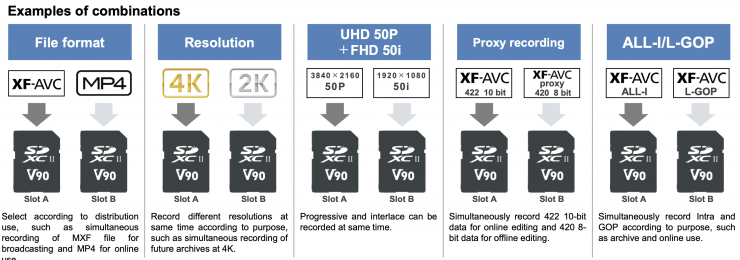
The C70 even allows you to record different resolutions at the same time. For example, you could record 4K DCI to one card and 2K to the other at the same time.
You can also record progressive and interlaced at the same time, so you could record UHD 50P to one card and HD 50i to the other. If you wanted to record different codecs at the same time, you could also do that. For instance, you could record XF-AVC ALL-I to one card and XF-AVC Long GOP to the other.
Media Type
Canon suggests using V90 SD Cards for most situations, especially Slow & Fast modes. As you never know, I would stick with the V90, and it would be a shame to limit your creativity because the card isn’t fast enough.
I did run into an issue with an Anglebird V90 64GB card. I got a dropped frame warning, and the clip was corrupt. Another time I didn’t get a warning, and the clip was black with no audio. It seems the 64GB size might be an issue, so I would avoid them and go bigger. I’m not certain if it has to do with Anglebird as I don’t have other V90 64GB cards to test with.
I think the main reason for going with SD Cards as opposed to newer CFexpress is the lack of any RAW recording options. If you’re holding out hope for Canon Raw Light, it won’t happen for this alone.
Keeping the C70 Cool
With such a compact body and the ability to shoot at high frames and 4K, the body has to be able to cool to prevent the dread overheating. Yes, the R5 release showed how important or embarrassing a camera that overheats quickly could be. The last thing canon needs is another camera with overheating issues.
The good news here is the C70 doesn’t have overheating issues due to the design and a cooling system that consist of a fan and exhaust system.
The C70 has an air inlet on the left-hand side of the camera and two outlets, one on the right side and one on the bottom of the camera. This way, the air gets pushed across both the main board as well as the sensor board to alleviate the heat.
The C70 has its ventilation and electrical systems separated to protect the sensor from water, sand, dust, etc.
Exposer Tools
The C70 has the tools you would expect in a Cinema Camera, Zebra, Waveform, and a new one, False Color. A first for Cinema EOS.
False Color
False Color is a very good way to judge exposure and the C70 has it, but it doesn’t show you the IRE scale that represents the colors. You will have to get used to the Canon color scale to trust it.
| COLOR | MEANING |
| RED | White clipping 100% IRE |
| YELLOW | Just below white clipping |
| PINK | One stop over 18% gray |
| GREEN | 18% gray (medium gray) |
| BLUE | Just above black clipping |
| PURPLE | Black Clipping 0% IRE |
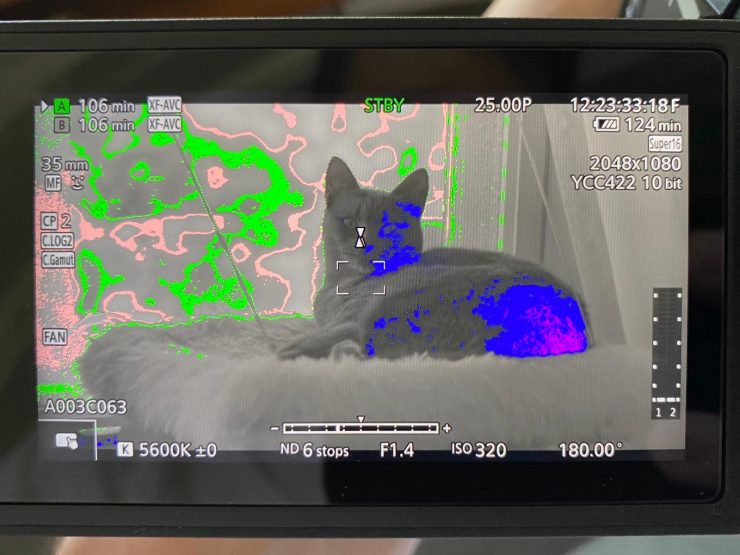
Histogram
The good ole Waveform is the tried and true for video production. I do like to pop it on just to check. While it’s very small, it helps to have it. The position can be changed from right to left, but you cant put it in a corner. It stays close to the center but on either side. This is good and bad as I can’t keep it on while shooting since it covers a critical area of the image, so I tend to pop it on and off when needed. The Waveform also can be seen when using the HDMI output.
The waveform monitor will not be affected even if a LUT is applied to the image, the range is changed, or anamorphic de-squeeze is used on the selected video output or screen.
Zebra Strips
The zebra pattern function shows black and white diagonal stripes over areas that are overexposed. There are two types of zebra patterns, and you can display both simultaneously.
Zebra 1 lets you identify areas within a certain range (±5% of a specified level from 5% to 95%), while Zebra 2 lets you identify areas that exceed a specified level (from 0% to 100%).
Electronic IS
Combination IS allows for coordinated control between the RF mount, an RF lens, and the electronic IS. If you use EF lenses through one of the adapters, you still get Optical IS, and Electronic IS in the camera, but they are done separately.
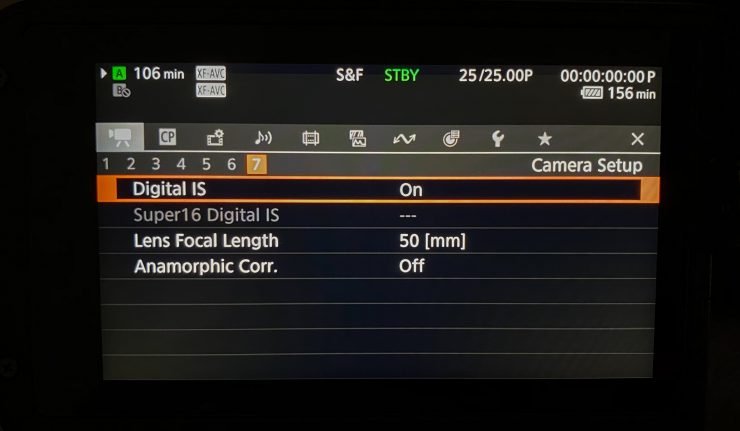
Canon claims that the IS performance is a lot better than using the conventional EF lens and electronic IS combination.
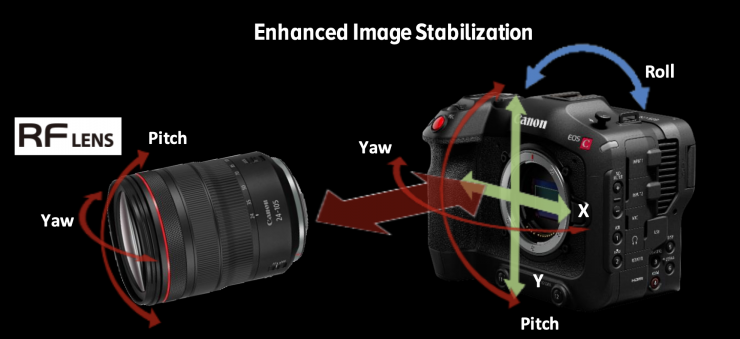
With normal IS activated, there is a 1.1x crop of the image, with Enhanced IS selected, you will get slightly more crop.
Availability
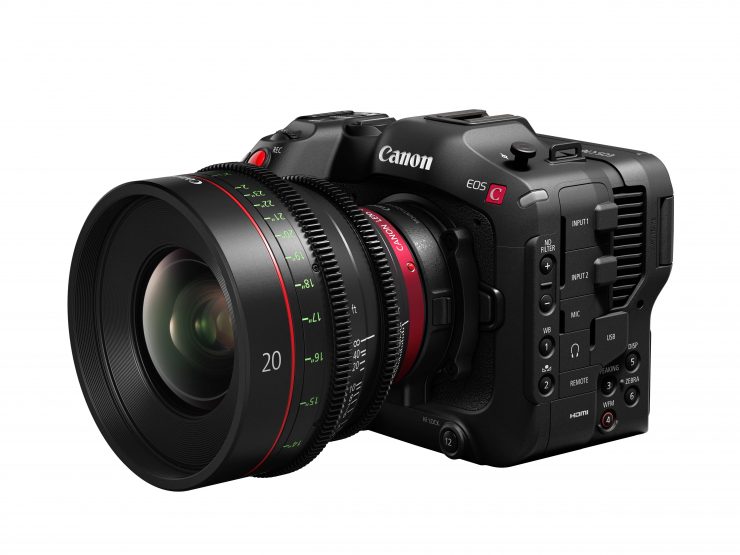
The C70 retails for $5,495 USD. It started shipping in November 2020 and was back-ordered for a long time. As of today, it is available on B&H and many other popular retailers.
More Cameras To Choose From
| PRICE | |||
| CANON C70 | $5,499 | ||
| CANON C200 (with EFV) | $5,499 | ||
| CANON C200 (body only) | $3,999 | ||
| Z CAM E2-S6 Super 35 6K Cinema Camera (EF Mount) | $2,499 | ||
| Z CAM E2-F6 Full-Frame 6K Cinema Camera (EF Mount) | $3,995 | ||
| Z CAM E2-F8 Full-Frame 8K Cinema Camera (EF Mount) | $5,995 | ||
| Panasonic EVA1 | $6,495 | ||
| Blackmagic Design Pocket Cinema Camera 6K | $1,995 | ||
| Blackmagic Design Pocket Cinema Camera 6K Pro | $2,495 | ||
| Sony PXW-FS5M2 | $4,748 | ||
| Sony FX6 | $5998 | ||
| Sony FX3 | $3,898 | ||
| Kinefinity TERRA 4K | $1,999 | ||
| Kinefinity MAVO 6K | $4,999 | ||
| Kinefinity MAVO LF | $7,999 | ||
| RED KOMODO | $6,000 |
Final Thoughts
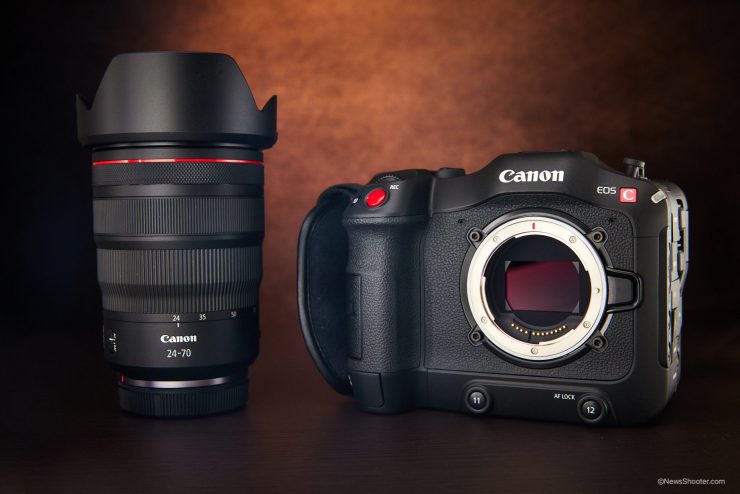
The C70 is an interesting camera. It’s a baby C300 MKIII on the inside. I think it’s a little strange to design the C70 with the ergonomics of a stills camera, but the popularity of using a hybrid for mostly video is common. To me, it seems like the wrong model to copy. If it had an EVF, then it would make a little more sense.
Not having an EVF is not ideal as the camera is harder to use outdoors in the sun. The saving grace is Canon DPAF is amazing, and touch focus works very well. You have plenty of exposure tools so getting the shot without an EVF is doable but not ideal.
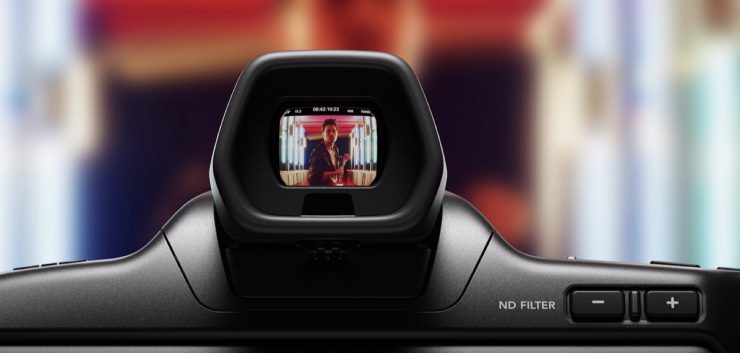
With the BMD Pocket Cinema Camera 6K Pro release, it makes me wonder if all these no EVF designs are coming around as the 6K Pro has an optional EVF that simply mounts right on top where you would expect a stock EVF to be placed. Smart design. Small and removable.
A big plus is the number of shortcut buttons the C70 has. I like how easy it is to operate. Once you get used to the placement of the buttons, the user experience is very good.
Shooting outside requires neutral density filters, and the built-in ND system is fabulous! I can change lenses quickly without fumbling with front-mounted variables or different ND strength type filters. With a simple push of the button and I have up to 10-stops of ND.
The touch screen is nice. The little shortcut it has that opens up a submenu with access to ND, ISO, F-stop, White Balance, and tool settings is very handy. I, with the C200, had this as it super fast to get to the settings I most use. Another shortcut that I like a lot is the Audio Status. This shortcut shows all the settings you have with all channels on the C70, and you can quickly make changes as well. Much faster than going directly into the menu.
Canon has done something special with the C70. It’s debatable if it can be an A-Cam. For me, I could make it one with a few pieces of kit. The price is fair as well, considering it cost $5500 compared to the C300 MKIII at $11,000 US. I think you get a lot more camera for half the price. On the other hand, an EOS R5 is $3900 and also has respectable video specifications; however, If I needed a video camera, I would grab a C70.
Like what we do and want to support Newsshooter? Consider becoming a Patreon supporter and help us to continue being the best source of news and reviews for professional tools for the independent filmmaker.

